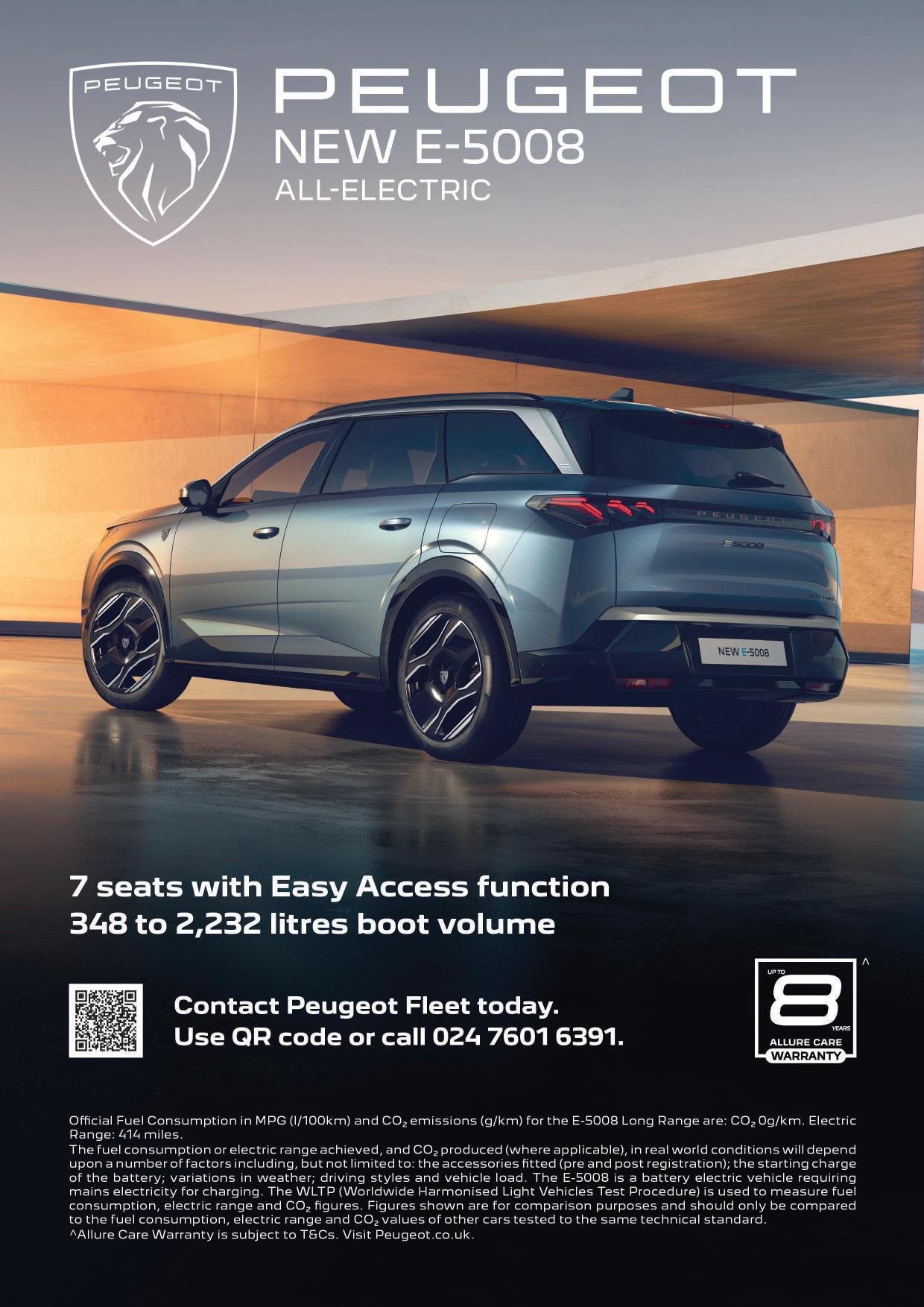
















Our December print and digital issue includes some helpful post-Budget insights from the BVRLA and the Association of Fleet Professionals, as despite the rise in EV and plug-in-hybrid BIK from next April, the plug-in van grant is still on offer, so it’s not all bad news.
We also meet up with Owen Shepherd, Head of Direct Sales for Volkswagen UK, to find out how the brand is progressing as it launches several plug-in and electric models, and take a quick look at the ID.7 GTX.
We also hear from charging experts Rolec and Mobilize as they help you make the transition to electric, and success continues for van leasing experts Vanaways as another company discovers why so many others are utilising its van expertise.
Cars
Electric cars are finally launching with driving ranges of over 400 miles, and our cover star the Peugeot E-5008 ticks that box and more, as we found out recently. OMODA is another new Chinese car name to enter the UK market, and in this issue we try out its electric E5. It’s a very driveable C-sector SUV which is priced competitively.
CUPRA has had an amazing 12 months in the fleet sector, and part of that can be put down to offering a broad range of electric and plug-in cars in our sector. Two new models are due to arrive in 2025, the Tavascan and the Terramar, but before that we spent a most enjoyable week in the performance Born VZ, an electric car that comes with thrills.
MINI has a range of new electric models and we were lucky enough to road test the Cooper Electric this summer. It’s different both inside and out from previous Minis but does come with some retro Mini touches as well as an improved driving range on the SE, of 249 miles.
As Jaguar Land Rover moves towards full electrification, it’s worth remembering that currently it has an excellent range of low BIK plug-ins including the Range Rover Sport P460e and Range Rover Evoque P300e, both of which we review inside.
Toyota’s C-HR has been a runaway sales success, but in our sector you need an EV or


PHEV to be competitive. Step forward the C-HR plug-in, which turned a few heads when we drove one recently. Elsewhere we take a look at the latest BYD model, the SEAL U-DM-i, the brand’s first plug-in hybrid and a car that’s set to add to its success so far.
IVECO has completely revamped its Daily range for 2024 with a new interior, better safety and new infotainment. We spent a day at Milbrook putting it through its paces, to discover just how much better it really is.
Mercedes-Benz eCitan is a small electric van fitted with a 45kWh battery and comes with a WLTP range of 175 miles. As we found out it’s perfect for urban driving – and won’t cost a fortune either.
The small eDELIVER 5 is MAXUS’s latest electric van, and mighty impressive it is, too. A whizz around Liverpool in one illustrated why this is a brand that’s going places.
Two years after it was launched the Volkswagen ID Buzz is still turning heads, as we discovered when we drove one. Is there a better electric people carrier? We find out.
And finally, ahead of an early 2025 facelift, we explain why the ISUZU D-Max V-Cross isn’t just a pretty face.
Finally, may we take this opportunity to wish all of our readers a very merry Christmas, and a happy New Year!
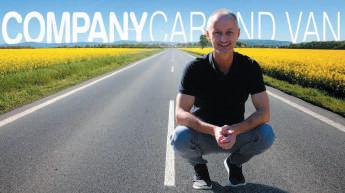
07734 264735 e: andrewmaxwalker@icloud.com w: www.companycarandvan.co.uk Follow us at twitter.com/andrewmaxwalker and www.linkedin.com/in/companycarandvan







Joining the smaller E-3008, Peugeot’s new E-5008 offers seven-seat practicality in the burgeoning electric SUV sector. With a 2.90m wheelbase and overall length of 4.79m, Peugeot has built a clever people carrier that doesn’t have too large a footprint. Andrew Walker takes a closer look at one classy, versatile motor ...
What is it?
Built on the new STLA Medium Electric powertrain, the E-5008 is the brand’s second new EV in as many months. The drivetrain comprises a permanent magnet synchronous motor operating in tandem with an electric gearbox to deliver more power, efficiency and torque, powered by a 400V lithium-ion battery.
In efficiency terms its range is massively improved over the preceding Stellantis BEVs, with up to 415 miles now available.
For AC charging, two types of on-board chargers are available, with an 11kW three-phase charger as standard. For DC rapid recharging, the Mode 4 socket on the new E-3008 is capable of charging speeds up to 160kW, enabling the E-5008’s standard range battery to be recharged from 20% to 80% in 30 minutes. Plug-in at home and on a 7.4kWh charger and charging takes eight
hours from 20%-100%, or six hours from 20%-80%. The E-5008 also features V1G or Smart Charging function which can adjust the time and power at which the battery is charged to optimise charging costs. If you want a Heat Pump it’s an extra cost item.
Battery and range
The E-5008 comes with two new larger batteries There’s a 73kWh battery with a range of 311 miles, the model we tested, and the larger 98kWh battery offering up to 414 miles of range. Both are single motor. A Dual Motor AWD will follow, fitted with the 73kWh battery and offering a 311-mile range.
From launch there are two trim levels, Allure and GT, both offered with the 210 Single Motor powertrain, with two more electric powertrains joining the range in 2025. The single-motor versions offer 345Nm/157kW or 345Nm/170kW.
The dual-motor AWD version provides a total power output of 320hp, a split of 157kW at the front and 80kW at the rear for a total 237kW. The front motor delivers 345Nm of torque and the rear motor 170Nm. Allure costs from 48,550, GT from £52,350.
There’s a redesigned front end with slim LED headlamps, lion’s claw vertical light strips and a large Peugeot logo in the centre of the diamond-shaped front grille. Both versions also come with Peugeot emblemed wheels, an aerodynamic profile, a narrow rear light band and a floating spoiler.
Interior
The i-Cockpit is still there but it’s had a major facelift. It’s now the ‘Panoramic’ i-Cockpit and features a floating, curved 21” HD panoramic screen with a head-up display with the central touchscreen. Slightly curved towards the driver, the screen looks fantastic.
Most functions are accessed through it but Peugeot has sensibly included i-Toggles, its fully customisable touch-sensitive buttons that can be programmed to provide quick access to up to ten of the user’s favourite functions – phone contacts, air-con and SatNav, for example.
The instrument cluster sits in front of the driver, combining all the information relating to driving such as speed, power, driving aids and energy flow. You still have Peugeot’s compact steering wheel now featuring touch-sensitive controls, but the larger cluster is far easier to see above the wheel than before, a major plus for taller drivers. Ambient lighting and Peugeot’s Air Quality System (AQS) also feature.
Fixtures and fittings
Quality wise it’s the finest Peugeot cabin yet. Our GT test car featured a light grey textile decor for dashboard, door panels and central console arch, Alcantara seating with leather effect seats and ‘Mistral’ black pillars and headlining. All of the finishes are excellent, including on the plastic glove box front and door pockets.
Our GT test car came very well specced and included dual zone climate control, heated and ventilated seats, a heated steering wheel as well as tinted privacy glass for the rear doors, a handsfree foot operated tailgate, front and rear parking sensors, a reversing camera, an 11kW on board charger, three 12V sockets located in the cabin front, rear and boot. Also included are automatic headlights, LED exterior lighting, pixel LED technology headlights with adaptive high beam assist, 3D LED rear lights and 20” ‘Yosemite’ two-tone diamond cut alloy wheels.
Performance and economy
Top speed is 106mph with a 0-62mph time of 9.7 seconds. WLTP combined range for our test car’s smaller 73kWh battery is 311 miles. WLTP numbers suggest the E-5008 can hit 4.6 miles per kilowatt-hour and on our test, which included motorways, we were just above 4 miles per kWh, so it’s doable. With zero CO2 emissions, BIK is a tempting 2%.
Sustainable design
Peugeot uses more than 500kg of green materials throughout the E-5008, including green steel and aluminium to make up 60% of the total mass of green materials. Recycled plastic is used in bumpers, deflectors, storage bins and carpets. Reducing the number of decorative inserts on the body and removing all chrome-plated parts from the exterior of the new E-3008 has further aided the car’s sustainability
Practicality and interior space
Up front there’s a twin cup holder in the centre console, a glovebox, decent sized door pockets, with the rear central armrest also featuring two cupholders and a smartphone



seats and a boot volume of 916 litres in a five-seat configuration, 348 litres in a seven-seat configuration and up to 2,232 litres in a two-seat configuration. You can also store the parcel shelf under the floor, a nice touch, or use this space to hide a charging cable.
There’s good passenger room on board with front seat passengers spoilt for head and legroom. The centre binnacle cocoons the driver in a comfortable driving position, with easy access to the new touchscreen and dashboard functions. Second row passengers get good headroom and legroom and all three second row seats are individually adjustable. The third row of seats enables the E-5008 to be a seven-seater but the space afforded by these isn’t really big enough for adults to use except over short distances.
Peugeot has made accessing the third row of seats easier than many, thanks to the easy access system. This allows the seats in row two to be fully tilted and slid forward simultaneously. Manoeuvring is with a control located on the upper part of the seat back, so when combined with the wide opening offered by the large rear doors, you can get on board or out, with some dignity.
The HD touchscreen is fully customisable with ‘over the air’ map updates for the SatNav. Wireless Mirror Screen for Apple CarPlay and Android Auto, DAB, AM and FM radio, Bluetooth with two microphones so you can connect to two phones, a Smartphone wireless charger and four USB sockets; two front and two rear also feature. We connected our iPhone seamlessly and the massive screen is both clear and easy to work, with the functions quick to load.

E-5008 has you very well protected and comes with adaptive cruise control with Stop and Go, lane keep assist, speed limit sign detection, automatic emergency braking with collision warning, lane departure warning, Driver Attention Alert, long-range blind spot monitoring and Advanced Traction Control.
E-5008 comes with Peugeot Allure Care, which covers the electric motor, the charger, the powertrain and the main electrical and mechanical components for up to eight years/100,000 miles. This is in addition to the specific warranty offered by Peugeot on all its electric vehicle batteries, guaranteed for eight years/100,000 miles for 70% of its charging capacity. Allure Care coverage is automatically activated for two years or 16,000 miles after each scheduled maintenance is carried out within the Peugeot-approved after sales network.
The new platform incorporates new front and rear axles and the single layer battery which sits low between the wheels. In theory this should help the ride, but as we’ve discovered it’s a near impossible trick to pull off.
However, although it shares its underpins with the smaller E-3008, the E-5008 feels more grown up as an electric car, more balanced and less fidgety; it’s all a bit of a surprise, but a nice one at that.
Elsewhere, the steering is pretty good and on a series of Cotswold roads, it managed to feel agile over undulating surfaces and through tight turns, with little or no body roll. The steering is quite light which is a bonus for urban driving.
Continued on page 6



Continued from page 5
The parking aids make tight spaces accessible. The paddle-mounted brake regeneration is a really good addition, as is the latest Panoramic i-Cockpit – still one of the best we’ve come across.
If you head out onto a motorway or dual carriageway, this will give you the opportunity to engage the adaptive cruise control, which with distance adjustment makes longer journeys stress free. It’s all carried out within a quiet cabin aided by the acoustic windscreen and the car’s sleek design. On our drive there were just two of us on board and progress was quiet and almost serene.
Driving modes and regeneration
As far as the driving regeneration modes went, we found that Low offers up a normal driving experience, Medium adds a tiny bit of regeneration and High a little bit more, but it’s some way off the ‘no-brakes required’ one-pedal offered on the KIA EV6 or Hyundai Ioniq 5, for example
With the three driving modes Eco, Normal and Sport these are as you’d expect. Eco tones everything down and will help you eke out extra miles. Normal is a bit more fun, with Sport the most noticeable in changing the car’s driving dynamics.
Pros
We loved the looks of the E-3008, but arguably the E-5008 is more handsom. As a seven-seater it’s nimble and good fun to drive. A choice of two large batteries with class-leading range, means the E-5008 offers far more appeal than previous electric Peugeots. On-trend tech and safety plus BIK of just 2% gives it company car appeal.
Cons
Other BEV seven-seaters offer more third-row head and legroom and a larger boot. Both versions are expensive to buy, so leasing is the logical way to get into one. When others offer one as standard, paying extra for a heat pump is a little tight of Peugeot.
CC&V VERDICT

A good looking, comfortable, well-equipped family car. Drives better than the smaller E-3008 and handles with more aplomb than larger electric offerings from Kia and Hyundai, for example.The only negative is the space in the third row of seats; it’s far from class leading, good only for children. But what is class leading is the battery range, which smashes all other seven and most five-seat SUVs out of the park, at 414 miles. A company car driver or fleet manager is most likely to want a long range on their EV over and above anything else, and on that count alone, the E-5008 is a resounding success.
Big battery means a brilliant range, but with driveability too.
CC&V RATING: N N N N N







Andrew Walker finds that even when asked to carry a heavy battery around, the Mini Cooper Electric still offers an exhilarating drive
Since it was relaunched in 2001, Mini’s success can be put down to BMW’s willingness to make the new versions as drivable as the original and to fit them with retro Mini fixtures and fittings.
Up to now they’ve definitely succeeded, but the introduction of a new electric Mini, with bigger, heavier batteries, could put that drivability to the test.
We spent some time in the Cooper E and SE, and here’s what we found out.
Model choice
There are two versions: E and SE. The Cooper E comes with usable battery capacity of 36.6kWh, up from 28.9kWh in the outgoing Mini Electric. This means it offers a WLTP combined electric range of 190 miles. The Cooper SE’s usable battery capacity is larger, at 49.2kWh, and comes with a WLTP combined range of up to 249 miles.
Cooper E pricing starts at £30,000, while the Cooper SE is from £34,500.
Exterior
They’re Minis – but perhaps not as cute or as recognisable as such, with a much more pared-down aesthetic. No fog lights, plastic wheel arches or chunky chrome door handles adorn the new model. It’s more streamlined with a less upright windscreen and and a less exciting front grille. There are also new corner rear lights and front circular headlights.
Interior
Inside it’s quite spartan compared to my 55 plate Cooper, bar the textile-inspired dashboard front which runs the width of the car and onto the door panels.
Slim horizontal air vents and the circular speedo infotainment screen are the only instrumentation on the dash, with some neat toggle switches located underneath. These include the starter button, driving modes (Experiences) and gear lever.
Beneath this on our SE test car was a portrait phone charging pad, twin cup

holders, an armrest and a storage space with movable covered lid that goes from front to rear through the centre of the car.
The interior door handles are chrome, narrow and cleverly hidden low down.
The quality throughout is excellent and to keep up Mini’s green credentials, much of what’s used is made from recycled textiles.
There’s a touch more room in the rear than you find on the original Mini Electric, while up front you now sit a little higher to accommodate the battery. Front seat passengers get loads of seat adjustment, while in the back the headroom is okay, though your legs may feel a little cramped.
It’s a small car so the space under the boot floor for cable storage is a plus, as are decent front door pockets and a small glove box.
Boot space is only 210 litres below the parcel shelf. The rear seats fold down in a 60/40 split with the height adjustable boot floor allowing flat access to the load bay.
The Cooper SE has a maximum charging speed of 95kW from a public charging point. That means a 10-80% top-up will take around 30 minutes. The Cooper E only charges at 70kW so the miles will be added more slowly.
Choose from three trim levels: Classic, Exclusive or Sport. Entry level Classic features LED headlights, a heated steering wheel, cruise control and two-zone climate control. If you’re prepared to buy the Level 1 extras package (£2,000), you’ll add a head-up-display, customisable front and rear light signatures, keyless entry, power-folding door mirrors, wireless phone-charging and heated front seats. All this is standard on Exclusive and Sport.
Exclusive trim adds additional exterior design elements, such as the option for a multi-tone roof with a combination of three different colours, as well as offering the front grille in Vibrant Silver. Sport trim uses high-gloss black as the frame for the front grille and logo colour with a contrasting Chilli Red roof and red/black bonnet stripes as further options. Adding Level 2 and 3 packs brings more goodies but pushes the price into £40k territory.
The system fitted to the Cooper electric is called the MINI ‘Interaction Unit’ and it runs an Android based System 9 operating software. This has been specifically designed to look and feel similar to a modern smartphone, so you can stream video and play games on it


too. It also offers the MINI Experience Modes whereby you can configure different settings: Core, Green, Go-Kart, Vibrant, Timeless, Balance and Personal. However, only three –Go-Kart, Core and Green – actually change the way the Cooper Electric drives, by either altering the levels of regenerative braking, allowing for an increased range, lightening or tightening the steering, which is most noticeable in town, and increasing or decreasing the accelerator response –something you’ll get hooked on in Go Kart mode.
The circular display is in keeping with Mini’s heritage, with the operating system, graphics and speed all very impressive. You also have an avatar in the voice control system; either a Bulldog or a cartoon Mini, which would certainly appeal to the kids. We only spent an afternoon fiddling with it and over time you’ll realise just how in-depth the whole set up is, so just beware of getting lost in the systems sub-menus.
Driving
We’d all like to think that driving a Mini will
offer up fun and excitement but my own Cooper diesel dating from 2005 never did either. It felt heavy, indeed it was, and the diesel engine just wasn’t powerful enough to offer hot-hatch driving. The electric Minis are even heavier. The Cooper E tips the scales at 1,540kg, the SE at 1,615kg (the old Mini Electric came in at 1,326kg). But while some have suggested that both are less fun to drive than the Minis that went before, we’d have to politely disagree. Cooper Electrics are great fun, with that hugging-the-road feel that many electric cars offer. Yes, you can feel the battery weight and yes, over poor road surfaces there are perhaps more jolts than in the petrol Cooper, but ultimately Mini has made a pretty good fist of making the latest electric models enjoyable to drive.
In reality, even at 1,540kg, compared to most, it’s actually a light EV, so don’t be put off by the fidgety ride on bad tarmac, as all EVs ride more or less the same in those conditions. And as a motorway companion we had no issues whatsoever, although with four adults on board it will feel a little cramped.
A much improved range over the Mk 1 electric mini. BIK of just 2%. Good fun to drive. Top quality interior and safety are a bonus and the retro touches are clever as well.
Cons
Fidgety ride on poor road surfaces. If you want a lot of goodies things start to get expensive. The infotainment is good but perhaps too many functions are controlled via the circular touchscreen. The exterior isn’t as fun anymore.
While many company car drivers are seeking a 300-mile+ electric company car, the Cooper Electric will appeal to those who don’t drive long distances but want a fun and good-looking car to drive every day. And of course, in either spec, it’s very company car tax friendly.
Some Mini aficionados, while seduced by the retro toggle switches and infotainment screen, may not be as keen on the spartan exterior, but its handling, ride and performance offer a large dollop of Mini DNA, and that’s good enough for us.
A treat of treacle sponge with custard
CC&V RATING: N N N N N

In the immediate aftermath of the Budget, CC&V met up with Owen Shepherd, Volkswagen’s Direct Sales Manager, to talk all things Volkswagen fleet, as well as discuss how the rise in PHEV BIK rates would impact on the brand.
Owen’s tackled that key question first: “In the short term, it won’t have a big impact. Volkswagen has a range of plug-in hybrids that offer customers who aren’t yet ready for full electrification, the option to drive a VW with an all-electric ranges of 60 miles or more. Plugging in at home or on the move to charge their plug-in enables customers to better understand how to live with an electric powertrain, readying them for a full-electric VW model in the next few years.”
On EVs, where BIK rates will start to impact from 2028/29...
“The good news is that the Labour Government hasn’t drastically altered the BIK rate on EVs, with an increase next tax year to just 3% keeping electric motoring costs low.
“We are continuing to work both with fleets of all sizes and with leasing companies to educate business users towards electrification. Our recent campaign, ‘Same

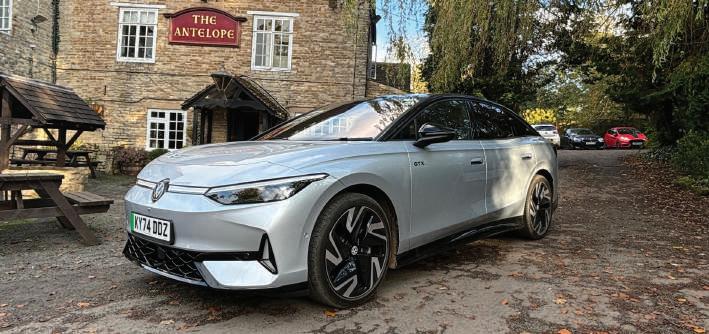
Spirit, Different Energy’, highlighted how an electric VW is a natural progression from driving a petrol or diesel one. It’s all about readying customers for 2035.”
Understanding the needs of different sectors in the race to zero - public sector, national fleet and SME fleet - is another area where Volkswagen is trying harder.
“With the public sector and large national fleets, it’s easier to help them transform as most have a dedicated fleet manager who is switched on to electrification and utilises
Volkswagen has 30 fleet retailers who specialise in corporate sales and who work with us to help customers in their transition to electric motoring “ “

Budget

telematics to save both their company and drivers money.
“It’s more difficult with SMEs, simply because there are so many of them, but we’re not shying away from helping them.
“Volkswagen currently has 30 fleet retailers who specialise in corporate sales and who work with us to help customers in their transition to electric motoring. They are aware of the different needs of company car drivers and fleet managers, and can offer help with their Volkswagen EV knowledge. They can also help with the options for new EV drivers around EV charging tariffs and home chargers.”
It seems that it’s business as usual at Volkswagen.
CC&V spent the remainder of the day driving the latest plug-in hybrid Volkswagen Tiguan, Golf and Passat plus the electric ID.7 GTX; our reviews can be read online at companycarandvan.co.uk
There are fears that the Budget could prompt widespread rewriting of company car choice lists to tackle new issues around plug-in hybrids (PHEVs) and double cab pick-ups.
The claim came from the Association of Fleet Professionals (AFP), which pointed out the viability of both types of vehicles will now be placed under serious questioning by many fleets.
Paul Hollick, chair at the AFP, said: “The Budget has tidied up the rules on company cars. The moves made on PHEVs and double cabs, as well as arguably on dealer employee car ownership schemes, removed grey areas.
“The government wants all company car drivers in zero emissions electric cars while paying benefit in kind at the standard rate. Almost anything that resembles a departure from this model has gone.
“This provides clarity but it does mean
some drivers and employers are facing big bills unless action is taken. When it comes to PHEVs and double cabs, this is likely to lead to widespread redrawing of choice lists with a renewed emphasis on EVs.”
The Budget clearly looked to dissuade use of PHEVs as company cars, with a jump from a typical 5% today to 18% in 2028-29. Similarly, double cabs will be treated as cars from next April but grandfather rights will apply to existing users until the 2029-30 tax year at the latest.
Paul said: “Drivers who have recently taken on a PHEV on a four-year cycle will see their tax rise massively in its last year.
“The situation for double cabs is perhaps less acute because of the grandfather rights situation but anyone still in a double cab after April 2029 is going to see an exponential increase in their tax. It’s possible that these
vehicles will almost disappear from car fleets, although there is some clarification needed if they are used strictly for work purposes only and taken home at night.”
The AFP welcomed the certainty provided of having benefit in kind tax tables provided through to the end of the decade, Paul added. “This is something that we have been requesting for some time because it means that fleets can plan for the future. While we don’t want to see benefit in kind on electric cars rise to 9% by 2029/30, we’ve accepted for a while that this will have to happen at some point, and the process appears to be being managed by the government in a structured and responsible manner.”
“Fleets should be looking entirely at zero emissions electric cars. When employers start redrawing choice lists, this should be treated as a central fact.”
Volkswagen has launched the ID.7 GTX as a top-of-the-range model in the VW electric line-up. We had the chance to drive it, and here are our thoughts.
What is it?
With an output of 250 kW this 4MOTION model comes with a 210 kW electric drive motor on the rear axle and an 80 kW motor on the front axle. They combine to form a dual-motor all-wheel drive system. With its 86kWh battery it is also the first model in the product line to feature an electric dual-motor all-wheel drive.
Anything special about it?
How about augmented-reality (AR) heads-up display as standard? That’s a first in its class. It’s also the first Volkswagen to be available with the new ‘Smart Glass’ panoramic roof, which can switch from transparent to opaque almost instantly.
Exterior
Unlike the other IDs the 7 looks more like a normal car than a specifically designed electric one. In GTX spec it has a distinctive front and rear. The front has a new bumper with a honeycomb grille and the complete roof section is all in black.
Interior
It’s much better than the other IDs and competes with cars in its class. You get a bright, airy, spacious cabin, helped by the large sunroof. Good quality finishes including soft-touch across the doors, dash and surfaces are also a highlight. The seats are large and comfortable with plenty of adjustment in the front.
Standard equipment includes 30-colour background lighting, App-Connect Wireless for Apple CarPlay and Android Auto and IDA voice assistant. The infotainment is also so

much better, with a large 15” touchscreen and logical menus
The new battery can be charged with up to 200 kW2 at DC quick charging stations, so charging the battery from 10 to 80% is in just 25 minutes. Faster charging on the go is also made possible by the GTX’s pre-conditioning whereby the battery is heated to the ideal temperature before the charging stop, so it can be charged at maximum power.
A spin around the Cotswolds saw us utilise the ID.7 GTX’s very comfortable cabin and ride, while driving along a mixture of motorway, A and B roads.
At a constant 70mph it’s one of the nicest electric cars we’ve been in. It’s quiet and refined, but if you need some extra power it’s there if you need it. In cruise control it’s just an easy car to be in.
On the winding roads around Leamington Spa the wide track and body weight meant




that it stuck to the road really well. With a low centre of gravity it’s a lot more fun to drive than many electric SUVs.
But it still feels like a large, comfortable, executive cruiser, with way more room and practicality than a Model 3 and pretty much everything else out there.
With decent torque on offer you can accelerate as required and although I was driving alone, I see no reason to see why it won’t perform just as well when fully loaded.
Real world range
We’d estimate that 280-300 miles is possible in warmer weather, if you stick to the speed limit and utilise the B regen. Miss any of those out and it will drop to 250 miles.
Spacious, practical, comfortable cabin.
Good quality fixtures and fittings. An infotainment system that’s finally worth praising. And despite its size, the ID.7 GTX is a driver’s car.
Cons
Doesn’t have the largest range. GTX versions cost more than standard ID 7s.
As a Volkswagen family we’ve been waiting for an electric VW that feels like a VW, and the ID. 7 delivered. Drives and handles better than most EVs and even gives the classconquering Tesla 3 and Y a run for their money. More expensive than a standard ID.7, but what the GTX adds is a bit of panache. A sporty ID at last!
CC&V RATING: N N N N N

The Autumn Budget has been praised by a commercial vehicle action group as showing that the new Labour Government takes the topic of van decarbonisation seriously, and is listening to industry.
The extension of the Plug-In Van Grant was particularly welcome as a key ask within the Zero Emission Van Plan, with an extra year confirmed by Chancellor Rachel Reeves.
A spokesperson for the Zero Emission Van Plan, said: “The extension of the Plug-in Van Grant provides welcome relief to a sector facing an uphill battle to meet ambitious decarbonisation targets.
“Many van operators are seeking to kickstart their transition to zero-emission
Extending the plug in grant is a positive step but will not surpercharge the transition by itself... “ “
vehicles, with cost just one of the key barriers blocking their path.
“Extending the grant is a positive step but will not supercharge the transition by itself. The Budget debate in Parliament about van electrification shows that the cross-sector Zero Emission Van Plan is gathering momentum.
“It is seeking increased fiscal support, improved charging and the removal of regulatory barriers are being heard by the people in the positions to make a difference.”



The coalition is led by the BVRLA and includes Logistics UK, Recharge UK, the Association of Fleet Professionals (AFP), and The EV Café.
The extension of the Plug-in Van Grant marks another key milestone in the Zero Emission Van Plan campaign, after securing a debate in Parliament that took in October. Addressing the topic of van decarbonisation, the debate explored the challenges
BVRLA praise for Budget plans but calls for more action
The Autumn Budget from the Chancellor demonstrates the challenging economic climate facing the nation, but contained some green shoots around road transport decarbonisation, according to the BVRLA.
BVRLA Chief Executive, Gerry Keaney, said: “This was a complex budget at a difficult time. The increase to employers’ national insurance will have a substantial impact on businesses and their customers. The full scale of its impact will only be seen in time.
“For our sector, the Chancellor has left many challenges unresolved. As penalties to stay in ICE vehicles ramp up in line with the ZEV mandate, more needs to be done. The barriers relating to the rental sector, charging
infrastructure, consumer education and the used EV market, all need close attention.
“The Budget did bring some green shoots of positivity, suggesting that the government is taking the UK’s transition to cleaner, greener vehicles seriously.
“The confirmation that the fair EV company car tax regime will be continued at least until 2030 is a positive step, supporting a vital contributor to the transition and a bright spot of success up to now.
“Extending the Plug-in Van Grant provides the sector with a much-needed boost.”
• For more on BVRLA and its views on the UK’s transition to green vehicles, see bvrla.co.uk

addressed in the Zero Emission Van Plan, prompting a positive response from Transport Minister Lillian Greenwood MP in which she pledged to support the transition.
• The full Zero Emission Van Plan can be viewed online now at https://www.bvrla.co.uk/ industry-campaigns/decarbonisation/ van-plan.html


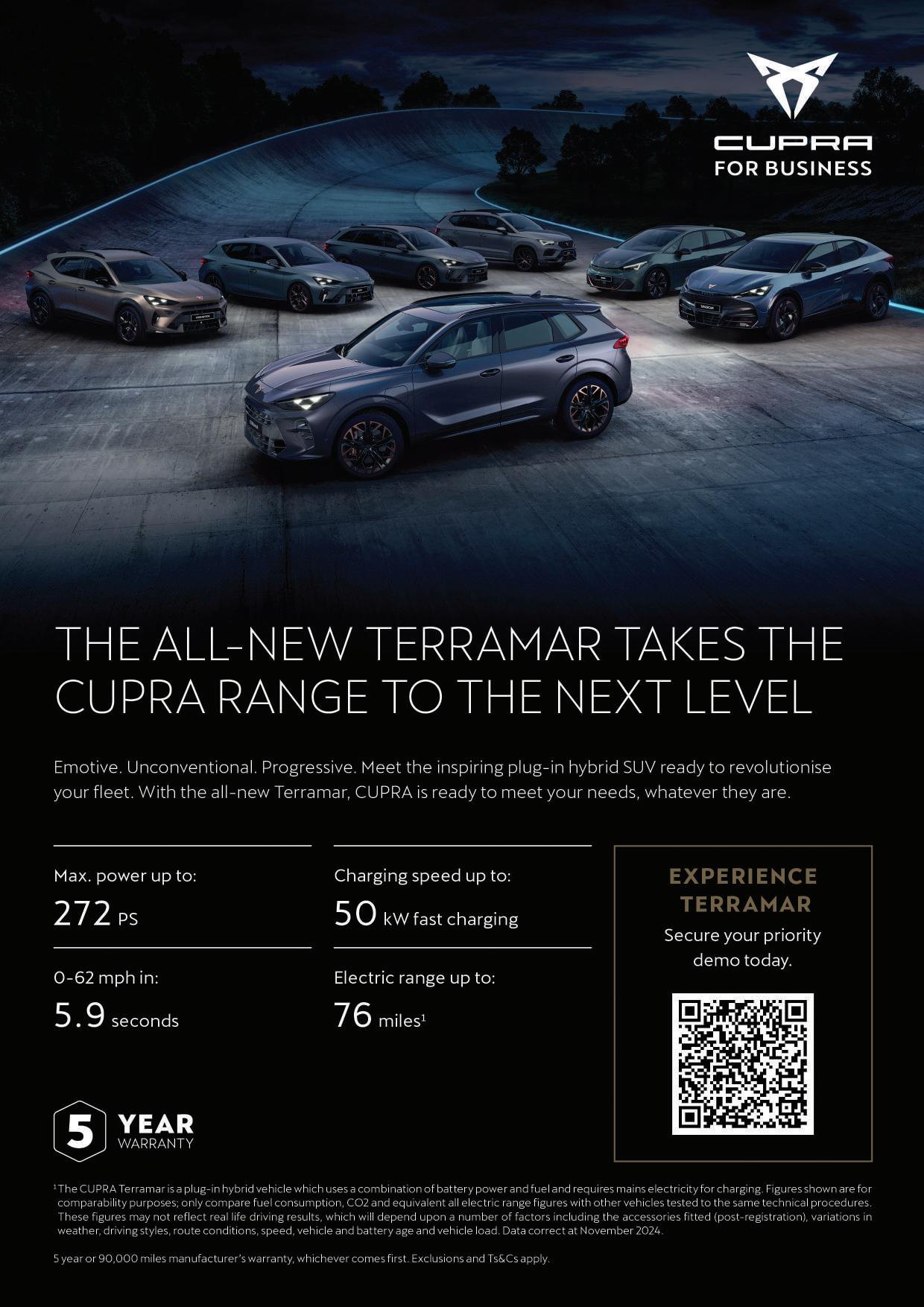

When CUPRA launched the Born, we liked it enough to give it a Company Car & Van Award as the Small Electric Car of the Year. The only thing it lacked was the CUPRA DNA, so its engineers decided to change that and came up with the Born VZ. Andrew Walker takes up the story...
What’s new?
First, the VZ moniker. It’s a shortening of the Spanish word ‘veloz’, which means ‘fast’. In order to achieve this the VZ comes with a new rear drive motor which produces 320 bhp. You also get lower suspension by 10mm on the front and 15mm on the rear, the latest generation adaptive dampers and some stiffer anti-roll bars. There’s also new software that tweaks the steering for example and improves the general usability of this Born.
Model choice
The standard Born specs offered are V1, V2 and V3. V1 comes standard with 19” alloys, heated leather steering wheel, LED headlights, LED tail lights, 12.9” touchscreen 5.3” digital cockpit, SatNav, Apple CarPlay, Android Auto, front bucket seats, rear view camera and sports suspension.
V2 adds an augmented reality Head Up Display, heated front seats and dark tinted rear windows. V3 includes 20” alloys, interior ambient lighting, 12-way electrically adjustable front seats, adjustable lumbar support and a massage function.
VZ comes with even more: 20” alloys, steering wheel paddles, a Tech pack, keyless entry and go, wireless phone charger, Car2X intelligent vehicle networking, CUPRA and VZ logo lettering in dark chrome,Sennheiser Premium Audio and Enceladus Grey Cup Bucket Seats Battery choice
Battery
Choose a V1 or V2 Born with a 59kWh battery, or the V3 and VZ with the 77kWh E Boost battery.
Safety
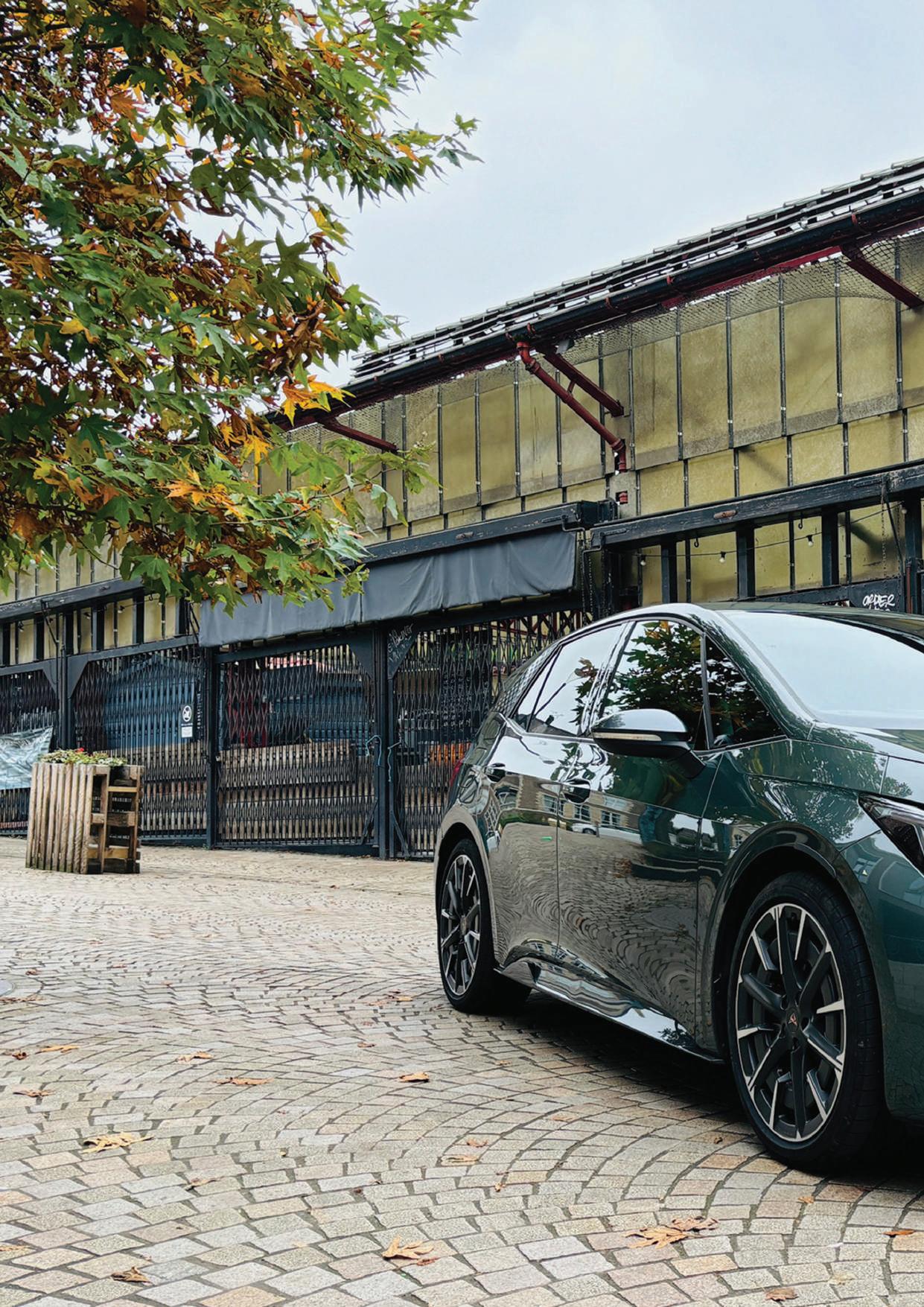
Inside
First up the gear lever is now mounted on the steering wheel and there’s a new shroud around the 12.9” touchscreen. They’ve also updated the Head Up Display, and bucket seats feature too, which make you sit lower and gives the driver a sporty vibe. It still feels classier than the VW ID.3 and the finish is decidedly flash in a nice way, with copper finishes dotted around the cabin. The steering wheel features two circular buttons to change the driving modes and even better, you can turn off lane assist and speed notification with just a couple of touches.


Standard from V1 are adaptive cruise control with speed limiter. Forward collision warning with automatic braking. Driver Alert System: Tiredness recognition, Lane assist and Dynamic road sign display.
Outside

It still looks like an ID.3 on steroids which is no bad thing. You get some subtle styling tweaks over the standard Born, such as dark chrome CUPRA lettering and VZ logo on the boot, plus new colours including our test car in Dark Forest. It sits squat to the ground too and really looks the part.


Range, battery and charging
CUPRA has added an extra 2kWh of capacity, taking the battery up to 79kWh. A claimed range of up to 372 miles means less charge station fretting, too. When you do stop the charging speeds has increased from 130kW to 185kW, so a 15-minute top up added 70 miles to my test car. Recharge at home on an a home wall box and it’s at 11kW, so a 0-100% charge takes 8.5 hours.
Cabin practicality and boot space
The VZ features a small gloves, medium sized door pockets, a large under armrest cubby, a wireless charging pad with USB C between the front seats, twin cup holders, a sunroof, twin USB Cs in the rear and a fold down rear armrest with twin cups holders. The rear hatch opens wide and offers up 385 litres increasing to 1267 litres with the rear seats folded. Charging cables can be stored in a cable bag, but there’s no space for this under the boot floor. Up front the bucket seats cocoon you in the low slung cabin. Head and legroom are good. In the rear it’s a five-seater but really only comfortable for four. Head rooms excellent but leg room will be tight if there’s a tall person sat up front.
Performance

The Born delivers with a 0-62mph time of 5.6 seconds. It’s amazingly quick from 0-50 mph and then the acceleration tends to tail off up to a top sped of 124mph. The addition of the driving modes Cupra and Performance selected via the steering wheel buttons add to the occasion. Three driving modes are available.


The VZ is as happy in town at slow speeds as it is when you really want to chuck it around. Local driving was quiet and comfortable in Range or Normal mode. There’s no annoying fake engine volume so it’s very much a silent hot hatch. On the local B roads around Tatton Park, Dunham Massey and out towards Jodrell Bank, it’s an awful lot of fun. The steering is incredibly well balanced with plenty of feel in and out of bends. Despite being RWD, the combination of the suspension, battery weight and tyres gives it plenty of grip, with a touch of oversteer if you get carried away.
The highlight though is how the VZ deals with road imperfections. Plainly the DCC Pro adaptive dampers are doing a very good job and the suspension doesn’t feel to hard nor too soft, a difficult trick to pull of in an EV. Brake regeneration is subtle and adds extra range. Combined with driving in Range mode utilising B regeneration definitely added a few miles over the week.
A 200-mile motorway round trip to the British Motor Museum saw us utilise adaptive cruise control and Apple CarPlay for Waze and podcasts. It all sets up quickly wire free and we loved the touchscreen’s clarity, simple left to right menu selections and general ease of use. We also used Spotify and the speaker system is a winner. Hands-free calls are simple and at motorway speed there was no volume issues.
Real world economy
Fully charged for a motorway trip, the VZ indicated a battery range of 279 miles. Starting as low as 2.6miles/kWh as we progressed at an average speed 56 mph for the entire journey, this climbed as high as 3.6miles/kWh which was far more encouraging. We drove in Comfort and Range mode at 70mph without air-con and reckon that the VZ in late October will give you a motorway range of 250 miles. Add in some urban drives utilising Range mode and the B regeneration and 300 miles seems infinitely achievable.
Pros
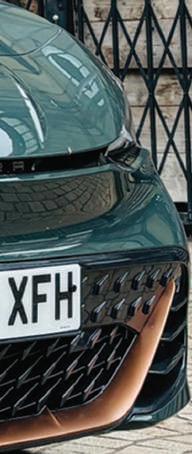

Looks and feels like a hot hatch. Handles like one too. Both the Cupra interior and exterior add to the fun. 2% BIK rising to 3% next April make it company car friendly. A kitten in town and cheetah elsewhere.
The brakes do a great job of brake regeneration but lack the feel of those fitted to a petrol Cupra. Range is good but not class leading. MG’s X-Power is cheaper.
Finally, a car built on VW’s MEB platform that actually delivers. Our faith in CUPRA’s performance engineering on an EV is restored and it makes the standard Born, and by default the Volkswagen ID.3, look tame. This is a car that will do the dirty work – school run, supermarket and long motorway trip – while offering some hot-hatch fun. Perhaps only two or three other electric cars can make that claim and one of those, the MG X Power, is nowhere near as composed nor as well built, despite being cheaper. The range may disappoint, but otherwise it’s almost, but not quite, perfect.
CC&V RATING: N N N N N
You’ve heard all about the benefits of electrical vehicles for the planet, but how does this continued growth in green transport translate into revenue opportunities for businesses?
Growth in the EV industry is being catapulted by supportive government grants (such as the Workplace Charging Scheme for state-funded education institutions, and the Infrastructure Grant for staff and fleets), progressive regulations (for example, Part S) and the rising demand for public charging infrastructure to support the EV driver on-the-go.
The benefits and continued progression are what make it an industry with reliable sources of income now and in the future. There are currently over one million electric vehicles registered, and this isn’t showing any signs of slowing down anytime soon. As these numbers continue to rise, charging infrastructure will also need to grow to meet demand.
The infrastructure is being made even more accessible thanks to the increasing presence of funding. Companies, like Wattif EV, provide fully funded, part funded, and subscription solutions to businesses who are looking to introduce EV charging but don’t have the upfront capital to implement it.
Fleet first
When you first think of EVs, your mind might initially go to homeowners and individuals. Although this is a demographic that has really championed the electric vehicle movement, there is an even bigger industry driving the transition to net zero. And that industry is none other than the fleet industry.
In fact, according to recent data produced by Samsara, ‘more than half of fleets operating 150-plus vehicles expect to have a hybrid or fully electric fleet by 2025’.
Sdiptech is a technology group focused on infrastructure that acquires and develops companies, contributing to the creation of more eco-conscious and efficient societies. Their objective is to generate sustainable value growth.
Earlier this year, we had the pleasure of visiting Sweden to reconnect with the Sdiptech team for their annual partnership awards. There we were recognised for our dedication and determination throughout the year and were proudly awarded Great Performer 2023, Special ESG Achievement, and Special Achievement.
To be specially commended by our partners like this has given us even more motivation to continue to provide advanced and sophisticated products to our customers, setting an example for how zero-emissions can be accomplished within a business’ daily practices.
So, what does this mean for Rolec and our valued customers?
More advancements and solutions that set a positive example of how zero-emissions can be accomplished.
Part of this spirit of innovation and growth has been channelled into expanding our range of products: introducing contactless payment solutions, new LCD screen models, and additional DC ultra-rapid chargers.
We have increased our DC offering to include a more diverse array of charging speeds, as well as an updated PAS 1899 accessible unit design.
The new UltraCharge 240, 80 and 30 meet the needs of businesses at each end of the electrification spectrum by providing charging speeds from 30kW to 480kW.
This range supports those just beginning to adopt an EV fleet to those looking for even more power from their charging network.

In 2024, our goal has been to enhance the EV charging experience. How? By expanding our technical services, doubling our support department, and introducing weekly product training. So that we can provide multi-levelled support on the ground and over the phone to nationwide installers of Rolec hardware.
Building upon the feedback provided to us over the past few months, we have been able to directly target areas of our support services that needed enhancement.
Optimising the customer experience and in turn doubling our customer satisfaction rating by creating a more seamless and reliable after sales support network.
We continue to encourage feedback from all of our customers; keeping the lines of communication open in order to remain reflexive to any concerns or queries that arise within our contractor and wholesaler community. As a result, we have experienced significant growth across all three of our niche sectors.
Continuing this outlook as we look towards the future, we are dedicated to regularly improving our customer experience; shaping a landscape of electrification that sees client success and progress working hand-in-hand. By prioritising the creation of a wellrounded system that starts at pre-sale enquiry and flows seamlessly to project assistance, quotation, onboarding and handover.
We’re currently on an exciting development journey aimed at seamlessly integrating these elements, and we look forward to sharing the news soon.
Speak to one of Rolec’s fleet charging experts at: 01205 724754 or email: fleetcharging@rolecserv.co.uk
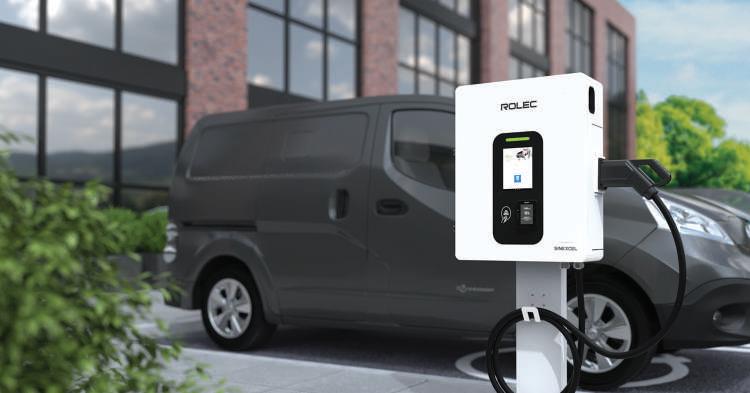


OMODA is another new Chinese car name that’s launched in the UK. Owned by Chery, it employs 80,000 people and has over 12 million customers, so it’s no start-up, with Europe the latest market the brand has launched in. It has already partnered with 60 dealers and it’s aiming to double that by the end of 2025. Two models feature in their opening salvo, the OMODA 5 and E5, a C-sector SUV powered by a petrol and an electric drivetrain. First up the EV.
What is it?
The OMODA E5 features a 61 kWh Lithium-Iron Phosphate battery pack and a single motor on the front axle developing 204 PS and 340 Nm torque and will deliver a range of up to 257 miles (WLTP). It will compete with the likes of the ID.3, CUPRA Born, Renault Scenic E-TECH, BYD ATTO 3, Kia Niro EV, Hyundai Kona Electric and MG4.
Model choice and price
Alongside its petrol engine stablemate, the E5 will be offered in the UK in two trim levels: the Comfort variant, from £33,055, and the Noble priced from £34,555.
Exterior
The front features the brand’s name and an X Shape with slim LED headlights and horizontal blade daytime running lights. At the rear there’s a large roof spoiler, LED rear
lights and the tailgate is slightly bulbous, rather like a Qashqai meets a Range Rover Velar, which adds some heft. The OMODA logo sits proudly in the centre between the light clusters. It’s unmistakably a medium SUV, the most popular size of car in the UK.
Inside
Chinese brands have in the past cut corners inside, but not so with OMODA. Everything you can touch and see in the cabin is made of good quality plastics and the finish is impressive too, although the grey-blackchrome colour combo plays it safe.
Up front, the driver gets a nice high driving position, so all around visibility is good. But the rear window is quite shallow and the C-pillars are large, so the on-board reversing camera is a bonus; it shows up clearly on the 12” screen.
As with other recent Chinese arrivals, the E5, even in Comfort trim, is generously equipped. You get a rear parking camera, with front and rear sensors, 18” alloys, LED head and tail lights, wireless Apple CarPlay and Android Auto, Adaptive Cruise Control, keyless entry and Blind Spot Detection.
Noble trim adds a 360 degree surround camera, a Sony 8-speaker sound system, a power sunroof, front and rear heated seats,
2-zone air-con, a power tailgate and an electrically adjustable front passenger seat.
OMODA has done a good job here as the E5 is kitted out with twin 12” screens which flow across the top of the dashboard. The one in front of the driver displays speed, range and all the usual car information. In the centre sits the 12” touchscreen, where you can access the car’s own SatNav, DAB radio, telephone, car settings and connect wirelessly in our case to CarPlay. It looks good and the icons and set-up are logical.
This isn’t surprising when you realise that it uses the Qualcomm 8155 ‘Snapdragon’ chip, which offers rapid responsiveness to user inputs and supports 4G connectivity, a Wi-Fi hotspot and over-the-air software updates. Furthermore OMODA has included a natural voice control using a virtual assistant which comes with an animal avatar.
Thankfully the E5 features some virtual and physical controls. A row of buttons for commonly-used features, such as climate control, are integrated into the centre console. In front of the driver is a handy 7” head-up display, so you can keep an eye on your speed. This also projects the navigation guidance and using mapping from HERE, this
enables the driver to view public charging stations along their route, which network they belong to, what they cost and whether they are available or in use. A nice addition.
Wireless Apple CarPlay and Android Auto feature with a 50W fan-cooled wireless charging pad for two phones, conveniently located in the centre binnacle for smartphone integration.
The battery and motor
The 61 kWh battery pack featuring Blade technology sits beneath the car’s floor. It’s made with an advanced Lithium-Iron Phosphate (LFP) chemistry, which is proven to offer enhanced durability and sustainability compared to a standard Lithium-iron battery found in most current EVs. The battery powers a single electric motor driving the front axle, and there is 204 PS and 340 Nm of torque.
Performance and driving modes
Acceleration from 0 – 62 mph takes 7.2 seconds, with a top speed of 107mph. There is a choice of three driving modes –Eco, Comfort and Sport – so you can tailor the driving experience to your preference. We tried all three and they do exactly as you’d expect. Eco dials the power down for slower progress but a longer driving range. Comfort strikes a better balance with more power released, and Sport goes the full hog, but will reduce driving range.
Range and regeneration
On a single charge the OMODA E5 can travel up to 257 miles (WLTP). While the vehicle is plugged in, preconditioning automatically heats or cools the battery to reach its ideal operating temperature, and having experienced the Blade battery on the BYD range, we know it’s one of the best for holding onto range in colder weather.
On the move, regenerative braking charges the battery when the driver lifts off the accelerator pedal. Drivers can select three settings – low, medium, or high – with the highest enabling ‘single-pedal’ driving. Single pedal driving is fast becoming a common EV benefit and the E5 will recoup under braking up to 80 kW of energy. It may be one-pedal but the regeneration isn’t as intrusive as the versions you’ll find on some other electric cars and we didn’t find it upset the car’s driving in any way. If you use it you will gain a few extra miles.
On Noble variants, a heat pump integrated into the climate control system draws energy from the air outside the vehicle and uses this to warm the interior instead of using just the electric heater. A definite plus.
The E5 features an 80 kW DC charging capability. This will charge the battery from 30-80% in 28 minutes using a public fast charger. Using a single-phase 7.4kW wallbox
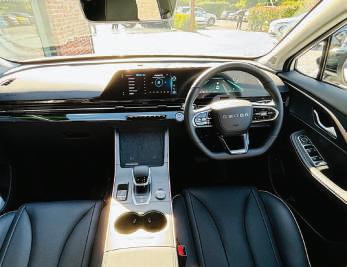
will deliver a full charge in under 10 hours. As usual plug-in overnight to utilise cheaper electricity tariffs.
There’s also an OMODA smart phone app for cabin preconditioning and the E5 features V2L functionality. When you’re parked up you can power a range of devices, with a socket in the luggage compartment delivering up to 3.3 kW of power.
A raft of 17 ADAS aids come as standard. These include Adaptive Cruise Control, Traffic Jam Assist, Lane Change Assist, Lane Departure Warning, Blind Spot Detection, Forward Collision Warning, Autonomous Emergency Braking, Rear Cross Traffic Brake and Door Open Warning. Enhancing safety is a complement of 11 airbags, including a centre airbag to mitigate the effect of any collision between the driver and front seat passenger.
The E5 cabin offers some decent storage and usability. Good news is that there’s a line of short cut buttons behind the twin cup holders in the centre binnacle for air-con, the de-misters, hazards, driving modes and to turn the infotainment screen on and off. So no fussing with the touchscreen, which we like.
Behind the buttons is a small cover cubby and you get an armrest with storage beneath, plus twin USBs, twin cup holders, a rear fold down armrest, decent sized door pockets and a mid-sized glove box.
The boot comes with a 380-litre luggage compartment, which extends to 1,075 litres with the rear seats folded, both competitive. The front luggage compartment offers additional storage space, a good place for the charging cable.
Front seat passengers get good space, but in the rear if you’re 6 foot or above, head height isn’t fantastic, perhaps as result of the panoramic sunroof and sloping roofline on the E5.
We spent a couple of hours on board the E5 on a route close to our offices in north Cheshire, which included A and B roads, some smaller country lanes and the motorway.
Driving between Wilmslow and Knutsford we discovered that the E5 rides well and hides the battery bulk, although there is
some body lean in and out of tight corners. Progress is quiet enough and the dashboard layout, steering wheel controls, including the right hand stalk to change gears, become familiar quickly.
The multi-adjustable driver seat enabled me to get comfortable, with a reach and rake steering wheel also featuring. I found the front passenger seat a little high and although it adjusts it doesn’t go down as low as I’d like.
On some faster A roads there’s plenty of power on offer and the E5 delivered nicely when we needed to overtake three-abreast cyclists. The brakes are very good but perhaps too good, with an immediate halt registering from the slightest touch. We became accustomed to this and by the time we had returned it wasn’t an issue.
We were following the SatNav via our iPhone, which was easy to do. The voice activation was on, so instructed us not only which way to go, but aided us in Google Maps by giving us the location of speed cameras and school zones, as well as informing us if we were breaking the speed limit.
Finally, we took a 20-mile motorway drive, and this was where the E5 really shone. We selected adaptive cruise control and let the car do the work. At 70mph the E5 remains quiet with just a whisper of road noise coming from the tyres. The on-board safety features including the car visualisation, which shows the vehicles around you, works really well, definitely an impressive addition to this low-priced car. If we had to drive 200 miles in the E5 we’d be able to do this in comfort and reach our destination hassle-free.
Incredibly well specified. We like the Blade battery. Excellent on-board tech and safety. Good looking, and 2% BIK ticks the company car box.
Our only real gripe is that the E5 plays it safe and by that we mean it’s very difficult to tell it apart on the road from the usual suspects such as the BYD ATTO 3 or MG4. And, of course, it’s new name in the market.
One of the better looking EVs. On-trend tech and safety will satisfy all. The 250-mile+ battery range isn’t bad and charges quickly. Does nothing wrong on the road but like its competition, is a bit vanilla to drive, which was a little disappointing. But to defend OMODA, that’s the sector the E5 is in, where the call is for safe, medium-sized family EVs with good range, easy to drive, well equipped and practical. And it definitely does all of that well. Decent first effort
CC&V RATING: N N N N


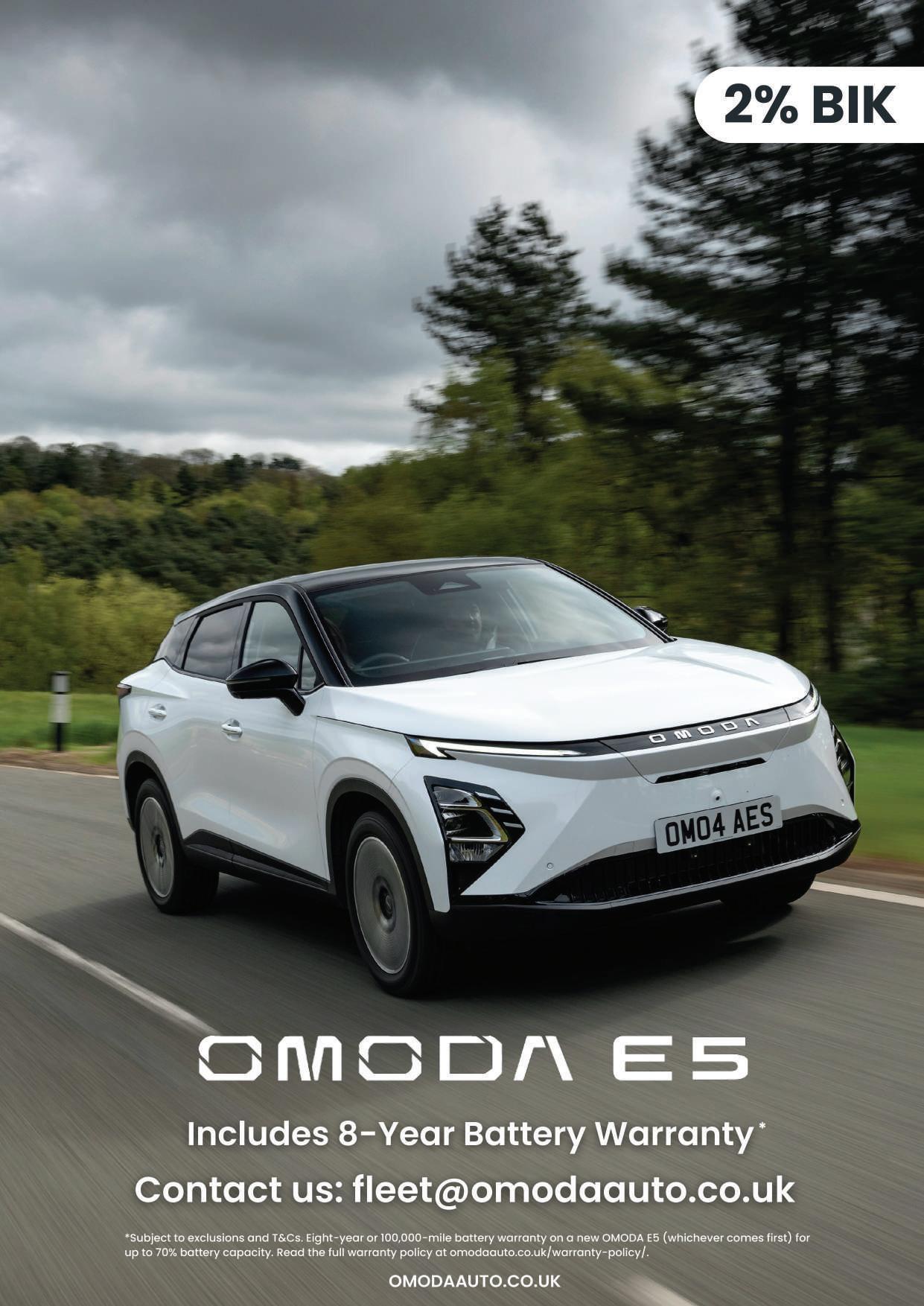
Three new vehicles and a near £500k site investment herald continued growth at a rapidly-expanding self storage and mobile refrigeration business.
Established in 2002, Container Team today employs over 25 staff under the management of new managing director Ricky Williams, who took over running the business last year, from its base in Weston-super-Mare.
The company operates under two brands: The Space Program offers secure self storage in shipping containers around seven locations in the south west and south Wales; while Team Refrigeration provides mobile freezers and chiller units in the events, hospital and hospitality sectors.
Combined turnover is nearly £4m, with Team Refrigeration seeing a seven-fold increase in the past five years.
There has been investment in new vehicles to enable increased sales and operations capacity for Team Refrigeration, supplied by Bristol-based Vanaways. Vanaways has provided Mr Williams with a new VW Transporter Sportline and two new Ford Ranger Tremor pick-ups to deliver mobile refrigeration units, taking new vehicle purchases to five in the past 12 months.
“It’s great to be part of Ricky’s journey as his business continues to grow,” said Gabby Bath, sales executive at Vanaways. “I’ve


known him for many years after we worked in the vehicles trade together, so he knows he can rely on me and the team to provide honest, reliable advice as well as the best prices.
“We’re all excited to see how The Space Program and Team Refrigeration develop over future years, and we’ll be here to support with vehicles whenever he needs them.”
“We’ve won awards for our customer service and it’s what makes us different from our competitors,” Ricky said. “The new Ranger will support our growth and allow us to deliver more of our trailers more efficiently and quickly around the country.
“We want to make sure that there’s minimal chance of customers having to wait for delivery, so reliable vehicles are vital in that respect.”
Cedric Ratnasingham and Gabby Bath of Vanaways, with Ricky Williams of Container Team. Cedric said:
“We’re sure Ricky’s ambitions will be realised, and we’re happy to partner with him and the team on that journey.”
Vanaways is itself undergoing spectacular current growth, having moved into new offices in Ham Green near the M5 at Bristol early last year.
Company turnover has risen dramatically, while the business is on track to deliver sales of more than 6,000 vehicles in 2024. In June this year the company was listed at 60 on The Sunday Times Hundred list of the UK’s fastest-growing companies.
“Our work with Container Team is a great example of what has fuelled our growth,” said Cedric Ratnasingham, General Sales Manager at Vanaways. “We share an ethos with those smaller businesses who pride themselves on customer service over short-term profit, and we’re keen to support as they innovate and grow.”

Despite a 6% dip in the UK’s new car market in October, the electric vehicle (EV) sector continues to grow. According to the SMMT, around 300,000 new EVs are now on UK roads.
EV adoption is driven in part by affordability, and there is encouragement that one-in-five pure electric models are now priced lower than the average petrol or diesel car – particularly when using schemes like salary sacrifice.
For organisations aiming to meet net-zero goals and cut costs, transitioning to electric fleets is more than procuring electric vehicles.
How vehicles are charged is pivotal to running a successful electric fleet. To help with this shift, Mobilize Power Solutions, a European leader in EV charging, offers three key strategies to drive fleet electrification.
1. Act now
The cornerstone of an electric fleet transition is a robust charging infrastructure. However, deploying workplace or depot charging is a complex undertaking that can encounter significant hurdles, such as energy supply limitations, planning permissions, or hardware availability. These factors can extend installation timelines from a few
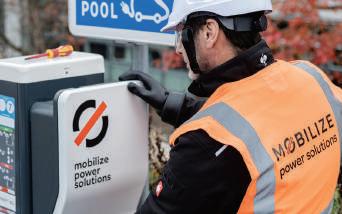
months to two years. Acting now is essential to ensure that your infrastructure is ready to support your fleet’s operational demands and future growth.
2. Future planning
Investing in charging infrastructure requires forward-thinking strategy. Design your facilities to accommodate future fleet expansion, incorporating advancements in vehicle technology, grid innovations, and the flexibility to manage dynamic energy loads. By building scalable and adaptable systems, your organisation can maximise long-term efficiency and remain prepared for industry evolution.
3. Leverage financial support
The Government’s Workplace Charging
Scheme (WCS) offers businesses an invaluable opportunity to offset upfront costs for charging infrastructure. Eligible projects can benefit from grants of £350 per socket, up to a maximum of 40 sockets or £14,000.
With the WCS set to close on 31st March 2025, it is imperative to capitalise on this financial support now.
For businesses seeking to preserve cash flow, flexible financing solutions are available. Mobilize Power Solutions, in collaboration with Mobilize Financial Services, offers tailored financial products to make your charging ambitions more accessible and sustainable.
The transition to electric vehicles is more than an environmental responsibility – it is a business imperative. Mobilize Power Solutions provides the expertise, resources, and financing to simplify this transition and future-proof your operations.
Want to know more?
Call us on 01923 381 931 or email: business@mobilize.com for more information about business charging at work, at home or on the road. alternatively visit: mobilize-power-solutions.uk

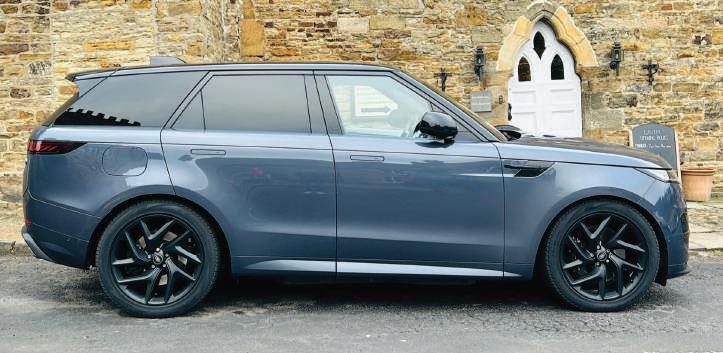
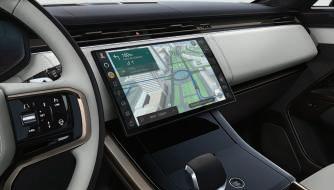
The Sport is no slouch with a top speed of 140 mph and 60mph hit in just 5.5 seconds.
It’s a privilege to get behind the wheel of a Range Rover Sport P460e, says Andrew Walker
Motoring writers are spoilt. A different car or van to review every week. Tough life. However, after 30 years in the game, even I have to agree that when the car in question is the Range Rover Sport P460e, it’s really not tough at all.
Two plug-ins are offered, the P460e SE and P550e, with P460e starting from an eyewatering £90,145, but that’s not the point. Its low BIK of just 5% makes the P460e, in relative terms, a bit of a bargain. You are also saved crom the new high VED rates on first purcashe, which could add as much as £5,000 to the cost of a petrol Range Rover. Ouch!
It’s powered by a 3.0 litre 6-cylinder petrol engine and a 38.2kWh battery that’s almost twice as large as the competition can muster. Claimed pure electric range is 73.3 miles, with 50 miles readily achieved in our time in the test car. To put that range in context, that’s as good as the original Nissan Leaf, so you can see just how far we’ve come in a decade.
The latest Sport is a lesson in less is more. It oozes kerb appeal, especially in our test car’s Varesine Blue with black exterior pack and bespoke 22” wheels. It’s unmistakably a Range Rover. Slim front and rear LED lights, pop out door handles and blacked out Range Rover wording only add to the aura.
Inside
Our test car featured a mix white and
ebony perforated Windsor leather seats with a white and ebony interior, ebony headlining, a panoramic glass roof and brushed aluminium finishes. Everything looks good and feels soft to the touch. The latest Pivi Pro infotainment is a major step up with a large 13.1” touchscreen and wireless Android Auto and Apple CarPlay capability.
Separate climate controls underneath handle the fan speed and heated seats.
There are three driving modes available. Eco – our preferred choice – Dynamic or Comfort. The standard vehicle setting is Auto Terrain Response, but you can also access all-terrain options such as Wade, Rock Crawl, Sand, Mud-Ruts or Grass-Gravel-Snow.
Our test car featured two charging cables in handy bags which do take up some space in the boot. The battery reduces the boot capacity to 647 litres but that’s enough for most people.
In the cabin you get two large front and rear door pockets, under armrest storage, twin centre drinks holders, a rear armrest with twin drinks holders, rear heating vents, heated seats and steering wheel and overall it offers plenty of leg and head room for up to five adults.
On a Rolec 7kW home charger (https:// www.rolecserv.com/ev-charging) the P460e will take five hours to charge to full. It also has the ability to be rapid charged using a DC unit up to 32kW, cutting the time to 80% full, to just 55 minutes.
Get on a special electricity tariff for EVs, plug-in at home at night when rates are 7.5p a kWh.
With such a high official electric range of 70 miles coupled to low CO2 emissions of just 17g/km, the P460e sits in the 5% BIK category for company cars. Claimed WLTP range is up to 382.4 mpg, which is amazing, but let’s be honest, unlikely.
To clarify, we ran it on local roads for a week, on short journeys, and managed 50 miles before resorting to the petrol engine. That’s brilliant. The trip info showed an average of 88.8mpg. We then drove it further and faster on the M6 and A66 on a 155-mile journey and this returned 38.7mpg – again, impressive.
Despite the fact that, at 2.8 tonnes, it is heavy, it is a lot lighter to drive than you’d expect. The steering is nicely weighted and the tyres offer plenty of grip. Body roll is negligible even over Pennine switch-backs. Push it hard and it behaves impeccably.
In town it’s quiet and comfortable and the eight-speed automatic gearbox feels refined and overall, forward progress is amazingly relaxing.
The good
For now, ridiculously low BIK of 5% means an annual company car tax bill of under £2,000. Brilliantly built, incredibly comfortable and amazingly capable. The 50+ mile battery range is a game-changer.
The bad
Expensive and you do lose almost 200 litres of boot space over the diesel version.
If you’re lucky enough to be able to choose a Range Rover as your company car, then the Sport P460e really is a no brainer. Nothing else bar the larger Range Rover PHEV comes close to its pure electric range and with such low BIK you’ll save, too. Comfortable, capable and refined as you’d expect, and as an added bonus, it’s sophisticated to look at and doesn’t shout too loud.
CC&V RATING: N N N N N


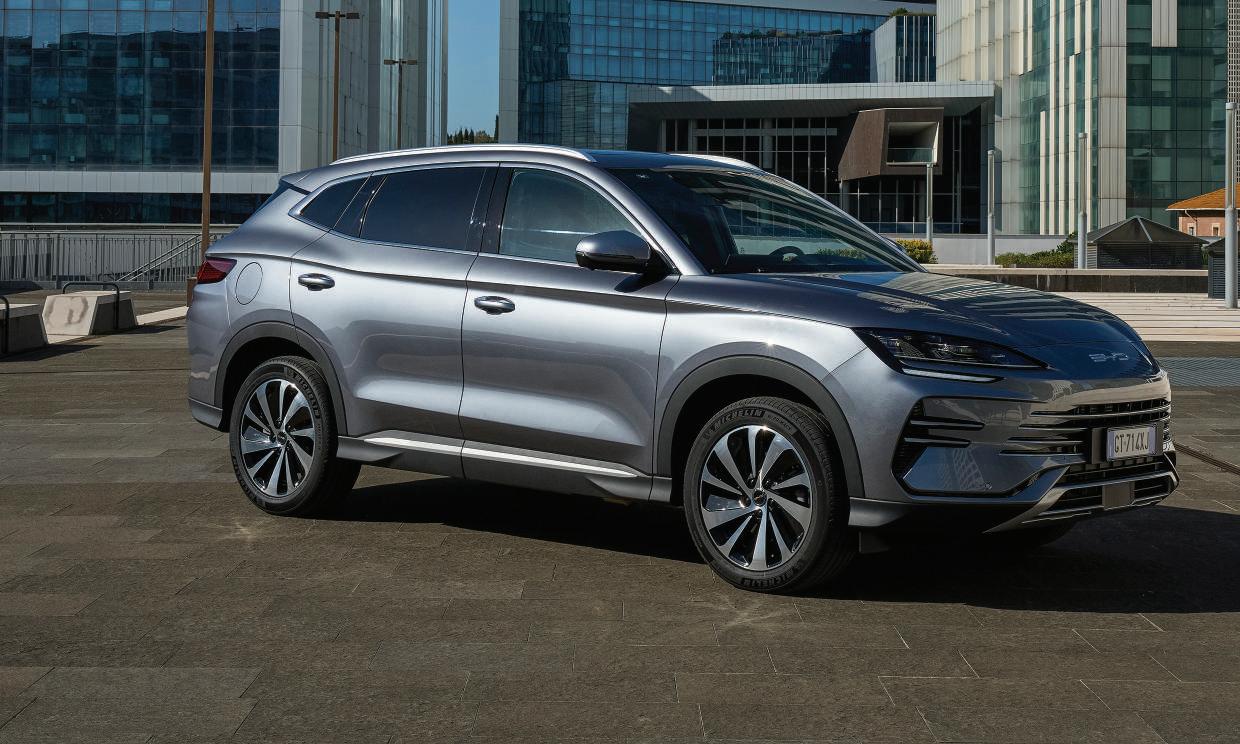
BYD has taken the wraps off its muchanticipated BYD SEAL U DM-i – a new spacious and comfortable five-seater D-segment SUV.
It is the brand’s first plug-in hybrid vehicle (PHEV) in Europe, and with a premium interior and high level of standard equipment, represents excellent value in its class.
For the first time, UK consumers can experience all the benefits of BYD’s advanced Super DM (Dual Mode) Technology which sets a new standard in intelligent PHEV innovation for exceptional energy efficiency, low fuel consumption and motoring performance.
Practical for longer worry-free journeys, the BYD SEAL U DM-i also produces a quiet, smooth ride that feels more like that of a pure-electric vehicle, with powerful acceleration and performance to match.
Offered in two trims with attractive pricing, the BYD SEAL U DM-i Design (all-wheel drive) price is £39,905, with the BYD SEAL U DM-i Boost (front-wheel drive) priced at £33,205.
BYD Super DM (Dual Mode) Technology prioritises eco-friendly, efficient electric driving with ultra-low petrol consumption, and longer range
Differing from other PHEV technologies, the BYD Super DM drivetrain prioritises electric power with minimal reliance on fuel, making it kinder to the environment, while effortlessly adapting to different driving conditions.
It comprises a highly integrated Electric Hybrid System, a 1.5L Xiaoyun Hybrid Engine (two variants depending on trim choiceDesign or Boost) with world-leading thermal efficiency and the ultra-safe, extremely durable cobalt-free (LFP) BYD Blade Battery tailor-made for the hybrid platform. A significant feature of the Electric Hybrid
System is its ability to intelligently switch between the two modes (EV and HEV) to prioritise electric propulsion whenever possible providing an efficient and more environmentally friendly vehicle. The engine charges the battery so electric driving is always available, with battery charge further assisted by regenerative technology.
The BYD SEAL U DM-i in Design trim (AWD) features two high-power electric motors (150 kW front and 120 kW rear) and an efficient 18.3 kWh BYD Blade Battery, complemented by the in-house developed 1.5L four-cylinder turbo-powered petrol engine, producing 96 kW. When working in conjunction with the two electric motors, the total system
Smooth, flowing natural lines give the SEAL a sense of power, strength and agility “ “
maximum power is 238 kW and the total maximum torque 550 Nm.
There is also the BYD SEAL DM-i Boost trim front-wheel drive option, powered by a 1.5L hybrid engine producing 72 kW operating with the 145 kW high-power electric motor, and also utilising the 18.3 kWh BYD Blade Battery. This produces total system power of 160 kW. The maximum torque power is 300 Nm. The BYD SEAL DM-i Boost offers an electric driving range of 49.7 miles (WLTP combined) and a total range of 671 miles when fully charged/fully fuelled.
Elegant and dynamic ocean-inspired design
The BYD SEAL U DM-i uses Ocean-inspired
design aesthetics, and is characterised by sleek, dynamic lines, and balanced proportions, with a distinctive X-shaped front face and U-shaped headlights that fit seamlessly into the body. A pronounced upper beltline extends to the tail lights with sleek, defined side skirts accentuating the body shape, giving the BYD SEAL U DM-i an elevated and stylish SUV presence. The 19-inch alloy wheels give the car a sporty vibe. All this, combined with smooth and natural flowing lines, gives the vehicle a sense of power, strength and agility.
The interior is equally enthralling, with a premium and refined feel and high-quality finish throughout. Ergonomically designed vegan leather upholstered seats compliment a cockpit inspired by a desire to bring quality and modern infotainment systems at a lower price point than previously possible.
Exceptional intelligence, safety and high standard specification
With an abundance of equipment and intelligent technology, and a high specification as standard, the BYD SEAL U DM-i provides a rich environment of smart connected experiences, and represents exceptional value in its category. The BYD Intelligent Cockpit System is operated via the central touchscreen, offering smart 4G connectivity and a range of infotainment. Occupants can enjoy a premium 10 speaker audio system. Features such as Head-Up Display and Intelligent Voice Control are standard, plus two front charging points (one of which is wireless) and two rear USB charging points.
Optimised for safety, the BYD SEAL U DM-i also has a comprehensive Advanced Driver Assistance System, with both active and passive features to make driving both safer and easier.
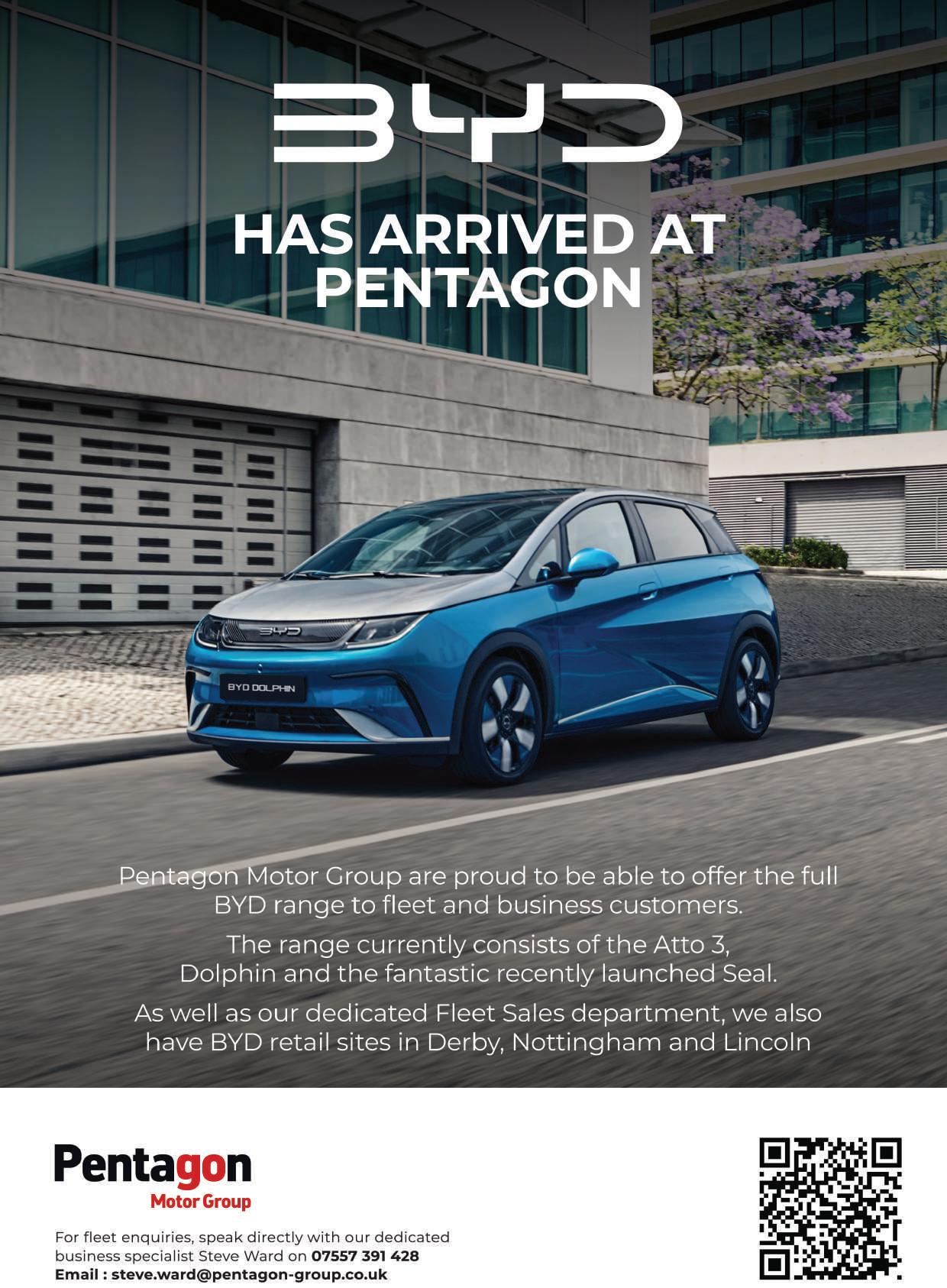
Range Rover has tweaked the Evoque plug-in to add an extra mile of electric range and tidy up the exterior and interior. We headed to the Cotswolds to see if these changes have made a very good car even better.
Engine
We’ll begin with the power train, because this IS the key to the PHEV’s low BIK and emissions. The plug-in features a threecylinder turbocharged petrol engine, plus an electric motor located in the rear axle. This gives the Evoque a pure electric range of 39 miles. While the 1.5 petrol engine offers a decent 200PS, it’s the extra 109PS courtesy of the 15kWh battery that really makes the difference, offering 540Nm of torque, enabling the 150kg heavier plug-in, to feel nimble. Indeed, it’s no slouch, hitting 60mph in just 6.1 seconds with a top speed of 132mph.
Model range and equipment
The plug-in Evoque is offered in four specs: S, R-Dynamic SE, R-Design Dynamic HSE and range-topping Autobiography. Start with the S. It features a rear camera, cruise control and speed limiter, Lane Keep Assist, front and rear parking aid, LED headlights, 18” alloys, leather seats, 12-way memory heated electric front driver seat, 10-way electric front passenger seat, wireless AppleCar Play and Android Auto, wireless charging, Pivi Pro with Connected Navigation and 11.4” touchscreen plus a 12-month Secure Tracker subscription.
As you can imagine the further up you go, the more you add: SE adds 19” alloys and a power tailgate. HSE is further enhanced with the addition of a fixed panoramic roof and 20” alloys. Range topping Autobiography includes 21” alloys, an ebony interior with extended Windsor leather and a tailgate spoiler.
Exterior and interior
The previous twin displays have been replaced by a single 11.4” screen which makes everything tidier. The loss of the lower screen means extra storage and room for a smartphone charging pad. Our Evoque featured the lovely looking ash veneer dashboard finish and the sliding panoramic sunroof that is standard on the Autobiography makes the cabin much brighter. Elsewhere, there’s a new stubby gear lever and some new trim and seat finishes including leather alternatives.
A couple of changes we didn’t like included the loss of physical climate switches and
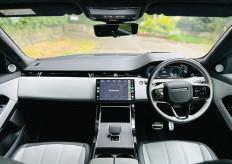


volume controls, which are now adjusted via the touchscreen.
Interior space and practicality
The cabin is a joy to be in.There’s some useful storage, with four storage bins, a cubby under the centre armrest, a rubberised tray on the centre console, decent door pockets and a glove box.
Rear space is a little tight and headroom is still a little compromised by the sloping roof and in our case the panoramic glass roof.
BIK and charging
With just 12% BIK on emissions of 33g/ km, the plug-in Evoque’s 15kWh battery takes approximately 2 hours 15 minutes to charge from empty on a standard home 7.2kWh charger, though a fast charger will do it in 30 minutes. One point: if the Evoque hit a 40-mile electric driving range it would reduce the BIK to 8%; a chance missed.
The city electric range is a claimed 46 miles the all-electric range 37.3 miles. Combined economy is as high as 190.9mpg but this is only achievable if you utilise the electric range as much as possible. In petrol mode alone, we only averaged 35.8mpg.
Drive in ‘EV’ mode and you stay on battery power alone, perfect for stop-start city traffic. On the touchscreen select ‘Save’ to utilise battery power in slow traffic, rather than it running out quickly if you drive on the motorway. It’s a useful feature.
Out and about
On the motorway there’s plenty of power and it cruises beautifully. The cabin is very

quiet, with little wind or road noise. On winding roads the small Evoque handled exceptionally well and I really couldn’t fault it. It really is a lovely car to drive.
Pros
12% BIK, fabulous cabin, quiet and comfortable interior, very well equipped, brilliant off-road, premium image.
Cons
With our range-topping P300e
Autobiography setting you back £60,385, the plug-in version makes most sense as a company car, leasing monthly. Rear seat space is tight. Misses out on 8% BIK by a whisper – and that’s a real shame.
Conclusion
For SME fleet customers who are lucky enough to be in the market for a premium SUV, we cannot recommend the plug-in Evoque highly enough.
The improvements further enhance the model range and we would put the Evoque at the top of the class for SUVs in its sector, until, or if, a pure EV Range Rover Evoque is offered with proper 4X4 capabilities.
Until it does, the plug-in will do nicely, thank you very much.
CC&V VERDICT
The baby of the Range Rover bunch has a lot going for it. Cruises beautifully and the city electric range is perfect for short journeys in stop-start traffic.
CC&V RATING: N N N N


Toyota’s C-HR saves us from some of the blandness in the current crossover sector, says Andrew Walker
It is unquestionably stylish in a sector of vanilla blandness. There are two petrol hybrids, a 1.8 138bhp petrol and the larger 2.0 litre 194bhp version. The 1.8 comes with a top speed of 106 mph and takes 10.2 seconds to reach 62mph. The 2.0 litre will hit a top speed of 112mph and 62mph in 8.1 seconds. The plug-in hybrid has a 13.6kWh battery pack, 220bhp, a top speed of 111mph, a 0-62mph of 7.2 seconds and all-electric range of 41 miles.
Every model is well-specced, with an 8” touchscreen, 7” driver information screen, Apple CarPlay and Android Auto, a reversing camera, LED headlights and Toyota Safety Sense, which includes adaptive cruise control, lane keep assist and road sign assist, on the entry model, the Icon.
MPG and CO2
Both the 1.8 and 2.0 litre hybrid engines are frugal. The 1.8 Icon has a combined economy of 60.1mpg and 105g/km of CO2 emissions, while the larger 2.0 is 57.7mpg and emissions of 110g. Better still will be the PHEV, with just 19g of CO2 and 313.8mpg combined range.
Style inside and out
Front and rear ends have been updated but

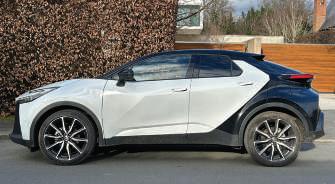
the most noticeable change is that the rear door handles are now in the door centre and not high on the door near the roof. The door handle pop out when you unlock the car.
In range-topping GR Sport you benefit from two-tone colours or can add this for extra on lower spec versions.
The even more aggressive front is finished off nicely by two highly placed narrow LED headlights and two Z-shaped strips that work their way down to the fog lights and front grille.
Inside is much more modern than before. and the build quality is up a notch or two. Design spec and above feature a large centre dash mounted 12.3” touchscreen, lower specs get an 8” version.
The glove box is small, but the 447-litre boot is generous with a high boot lip.
Choosing the 2.0 Hybrid means there’s a 12v battery in the boot, so you lose 17 litres.
There is good driver and front passenger
head and legroom but legroom is less in the rear. It can feel a little cramped and claustrophobic, not helped by the jet black roof lining, narrow rear windows and chunky rear C-Pillars.
On the road
Very comfortable ride and decent handling, with all four passengers benefitting from the supple suspension and lack of body roll that’s on offer. The relatively high driving position offers a good view of the road ahead.
Eco driving mode is great for motorways, use Normal around town and Sport on the open road. In town there’s often enough power in the battery for electric only driving and the car will pull sharply away in silence. At a constant 20-30mph we were averaging the best part of 65mpg, while adding motorway driving saw this even out at 51mpg.
Updates have definitely improved it. Still looks great but now comes well equipped, with the latest tech and safety across the range. Fleet customers will be happy with the plug-in hybrid’s fuel economy and lower emissions, equating to low BIK. The only compromise is a small boot and rear legroom.
CC&V RATING: N N N N
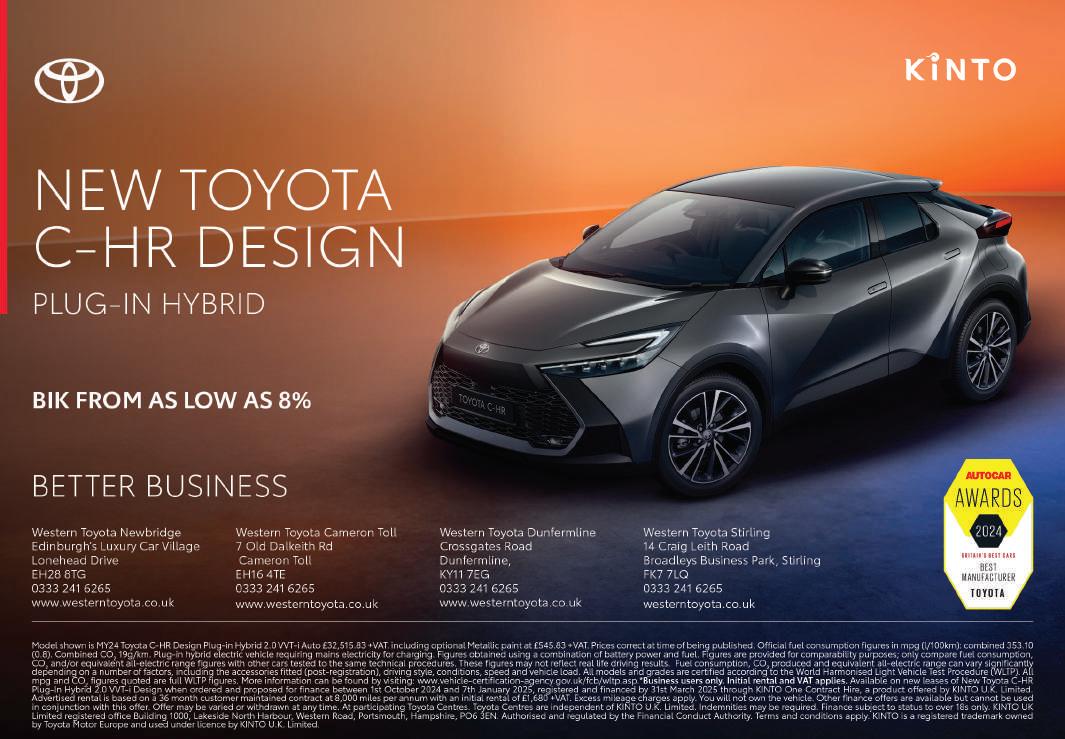
Isuzu’s new D-Max landed in the UK at exactly the right time for the Japanese brand. As established players left the sector and others waited for their new models, Isuzu was able to increase its foothold in the burgeoning UK pick-up sector.
The previous D-Max range topper, the Blade, had a reputation for toughness, reliability and durability. What was slightly lacking, though, was the more car-like interior, on-trend tech and safety features that some of its competition boasted.
The former attributes are still there – this is a pick-up that will go almost anywhere –but updates mean it’s now improved where once it was lacking, particularly on ride and handling.
There are three options: Business, AllPurpose and Adventure . All have four trim levels – Utility, DL20, DL40 and V-Cross, plus the steroid-injected Arctic Trucks AT35. We had the opportunity to drive the V-Cross from the Adventure range.
The 1.9 litre 162bhp engine has been carried over from the previous model. The ladder frame chassis, while similar to before, comes with larger rails, additional bracing plus newer steels, all of which have contributed to make it stronger.
There’s a longer wheelbase, re-designed rear suspension, a shorter body, with increased load space inside and out.
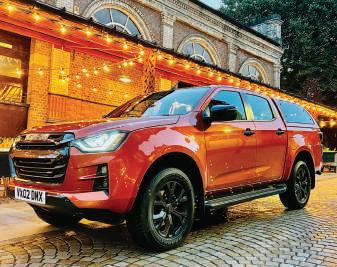
The updated D-Max now features a new front grille and updated wheel designs on the All-Purpose and Adventure models. The Business range has kept its durable steel wheels that are characteristic of the Isuzu D-Max Utility model.
The hard-wearing cloth interior of the Business range models has remained, while the seats of the Isuzu D-Max DL20 are now covered in a more premium woven fabric with a refreshed design.
Every version has a payload rating of at least 1,070kg and a 3.5 tonnes towing capacity. The D-Max weighs under 2,040kg, meaning it is subject to normal passenger car
speed limits. Many double cab pick-up trucks – Ranger and Hilux for example – exceed this weight limit so must comply with goods vehicle speed limits, which are 10mph lower on single and dual carriageways
Still perfect for anyone who needs to use their truck off-road. The selectable shift-onthe-fly 4WD drive engages faster, and hill descent control and hill start assist are a bonus. It also has a wading depth of 800mm.
Emissions and fuel economy
V-Cross manual offers 33.6 mpg/auto 30.7 mpg with emissions of 220g/km and 241g/km respectively. On the it’s road so much better to drive than the old Blade model, and is now competing with the latest Ford Ranger and VW Amarok. It handles the road more like a large SUV than a pick-up.
While other manufacturers shied away from pick-ups, Isuzu is to be congratulated for sticking to the sector. Our reward is a pick-up that’s great to drive and has been improved inside and out, and it’s now a contender as a lifestyle vehicle
CC&V RATING: N N N N






The IVECO Daily had an update for 2024, and CC&V spent a day at Millbrook taking a look at the new model
What’s new?
The latest version is a lot more competitive, with new connectivity and upgraded on-board tech plus improved cabin ergonomics. There’s also an increase in payload, and new rear leafspring suspension enabling heavier loads.
The model choice is extensive. There are three specifications – Business, Evolution or top-spec Connect – and three wheelbases, five body lengths and three roof heights. And it’s offered as a panel van, chassis cab, box van, crew cab and as a 4×4 model.
It also comes with a separate chassis and body construction, meaning that it’s able to deal with heavier stuff than most of its competitors. Gross vehicle weights range from 3.5 to 7.2 tonnes and body lengths go up to 6.75m.
Leading with a 2.3-litre diesel engine that comes with three power offerings, 116, 136 or 156hp and a more powerful 3.0-litre diesel engine with 160, 176 or 207hp options, the range also includes electric and bio-CNG versions.
Inside
There’s a new one-piece dashboard which features loads of useful open and closed storage spaces designed specifically to hold a phone, a tablet or your laptop. Four USB type A+C sockets and a new wireless charger also
feature, plus there is a really useful 10.25” configurable digital info cluster.
You also get a 10” colour display integrated into the central section of the dashboard. In-cab functions such as lights, windows and climate can be controlled with voice commands through IVECO Driver Pal, which is now integrated into the system. Tom Tom Live advanced navigation services is available.
Quality is better with memory foamcovered seats and improved plastic finishes. You also get reach and rake steering, air-con and a DAB radio fitted as standard. Plus Keyless Entry and Go is an option. The Cabin finishes are practical and hard wearing but aren’t class leading.
Entry level Business is missing a few key features such as adaptive cruise control, so customers may want to move up to the Evolution or Connect versions.
The MY24 Daily now comes with the most up-to-date ADAS and Level 2 Autonomous Drive features including Traffic Jam Assist and Adaptive Cruise Control with Stop and Go.
While the Daily may not be quite as refined on road as some offerings, it’s nonetheless a comfortable and practical vehicle. We got behind the wheel of the 3.5T Hi-Matic panel van and we’d definitely recommend the automatic version, with 66% of Daily sales being auto. Having an auto box enables far easier progress and the Hi-Matic gearbox is a beauty, enabling drivers to be more relaxed at the wheel and make light work in city situations.
We took the van onto the M1 for a quick junction drive and with Adaptive Cruise
Control engaged it’s a cinch to drive. Acceleration is decent, and the cabin is nicely insulated against outside road noise, too.
The new safety features work well. We tried them out on a specially constructed safety test route at Millbrook Proving Ground and the pedestrian safety ones were particularly impressive.
The electric power steering makes light work of urban driving. Even unladen, the ride impressed, and it improved with a load on board. The new dashboard is easy to live with. Overall refinement isn’t quite up to the Sprinter or new Renault Master, and the Daily’s fuel economy isn’t fantastic either, but the floating driver’s seat is a definite winner.
Pros
Massive choice of models. Strong line-up of engine choices. On trend tech and safety now features on all versions. The Driveway Programme is a winner.
Cons
Diesel engines aren’t the most refined. The Cabin finishes are practical and hard wearing but don’t expect soft-touch plastics. Fuel economy is at best 34.6mpg.
Existing Daily customers will be very happy that it comes with the latest tech. Slight tweaks to the Hi-Matic set-up mean it’s better to drive, and for longer motorway journeys improved safety make life so much easier. IVECO’s Driveway Programme is a real plus as well.
CC&V RATING: N N N N


Chinese LCV brand Maxus is producing some remarkable vans. Here’s how we got on with its eDELIVER 5.
What is it?
The eDELIVER 5 is a baby brother to larger electric siblings the eDELIVER 7 and eDELIVER 9. In size terms it’s reminiscent of the old Nissan e-NV200 and sits between the smaller electric offerings from Nissan, Renault and Mercedes and the larger eDELIVER 7, Ford E-Transit Custom, Vauxhall Vivaro electric and the Renault Trafic E-TECH.
Model choice and driving range
Two versions are offered: the L1 H1 and the L1 H2. Both are fitted with a 64kWh battery for a driving range of 208 miles combined WLTP or 300 miles urban driving.
Battery and power
Peak power is 120kW, with peak torque 240Nm. Both versions are FWD and comes with a top speed of 75mph.
Charging
DC charging time 10-80% is 0.7 hours, with AC charging from 5-100% taking 7.5 hours. The port is located on the front right hand sides of the van.
Equipment
ED5 comes well equipped, too. Electric power windows, two speakers, 7” LCD instrument cluster, 12.3” infotainment screen, with MP5, USB, Bluetooth, wireless Apple CarPlay and Android Auto, DAB, a 12V socket, USB interface, smart keys and an excellent air con system. The 12.3” centre touchscreen was a real highlight, with clear graphics, fast responses and simple to understand inputs.
Outside
MAXUS has created a very cute looking electric van. It looks very much like the smaller eDeliver 3 in shape. However, it features a narrow black band at the front with ‘C’ shaped LED daytime driving lights, the Maxus logo in the centre, and a lower down grille featuring twin circular spaces. The rear is minimalist too, coming with three oval-shaped lights on the edge and centre of either side.
Inside
It’s very minimalist, with the centre infotainment touchscreen located in the centre of the dashboard. Low down to the left


of the driver sit the controls for the electric mirrors, lights, de-misters, electric parking brake and EV switch, and that’s it.The steering wheel houses the cruise control on the left and the phone, volume, voice control, level of brake regeneration and the driving mode controls on the right. The wiper stalks are on the left and on the right, you have the gear selector. It’s by far the least busy cabin we’ve ever sat in, and all the better for it.
The overall quality of the seat fabrics, dash and door finishes and switchgear is pretty good. It’s all usefully black and grey and the rubber floor protectors will keep that area clean as well. None could be described as ‘soft-touch’, however.
If you drive in and out of an urban area, the ED5 is the easiest vehicle we’ve ever driven for that environment. When you climb in the engine starts automatically, select D and away you go.
The highest level of brake regeneration gives you one-pedal driving so you rarely need to use the brakes. In Eco mode the battery power is reduced and in maximum regen, the van moves quite slowly as it harnesses as much energy as possible. Move into Normal driving mode and it feels nimbler as more power is released. If you really want some dodgem car-style fun you can turn the regen off and select Sport mode, at which point the ED5 literally shoots ahead.
Access to the load bay is good, with sliding doors on either side. The lack of any centre gear stalk means the driver can access or exit the cab from the passenger side and the

60:40 rear doors open wide enough to get most things in. Only the wheel arches intrude into the load bay space.
If we’re going to complain about one thing, it’s the ride quality. A combination of the battery weight, slim tyres and seat thickness do contribute to a rather firm ride.
To be fair to Maxus, it’s a problem which almost all EVs, and many plug-ins, share, so don’t expect a magic carpet French ride, especially over the current road surfaces across the UK.
Looks-wise it’s a head turner. Anyone driving it will smile, a lot, as it’s just so easy and relaxing to pilot.
The minimalist dashboard and vehicle controls are a winner. The load space and ease of access to these is very good.
The ride is a little firm. Cabin storage could be improved, and it has to be said that both versions don’t come cheap.
Maxus has come a long way in the design of its vans in just a few years, and that should be a warning to rivals. The eDeliver 5 is the best of the bunch, with cool looks and a minimalist interior that’s right on trend.
CC&V RATING: N N N N N







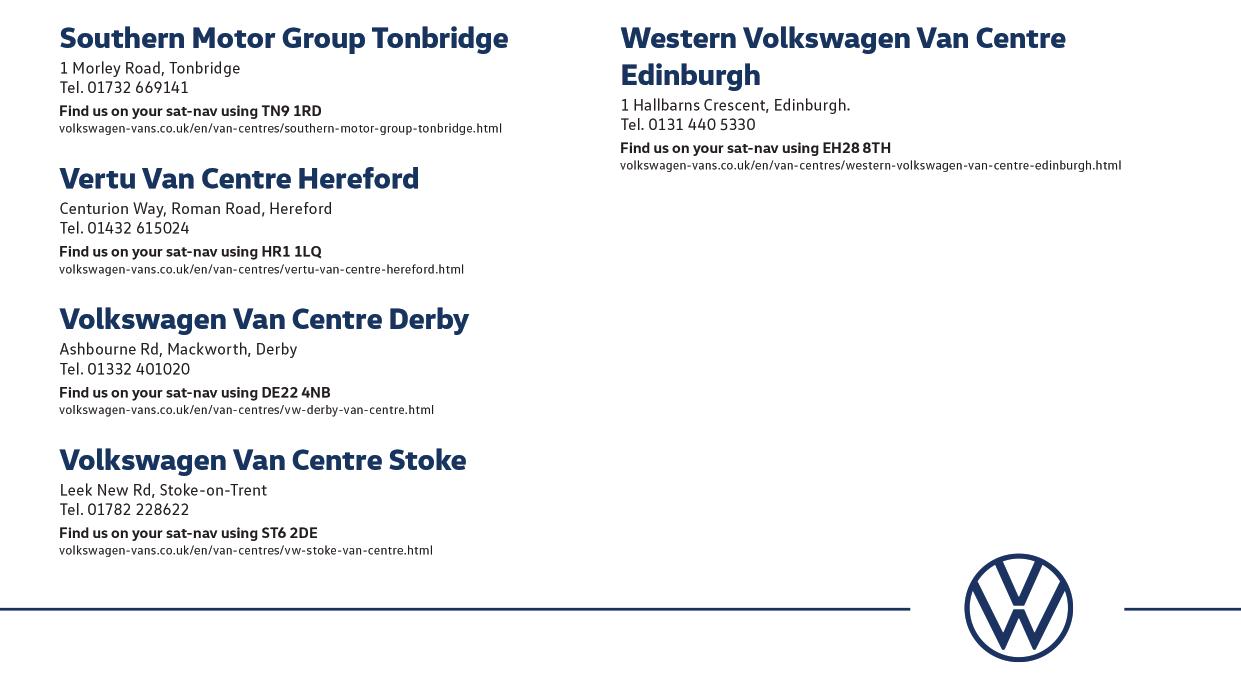
VOLKSWAGEN’S ID.Buzz was the first all-electric microbus and panel van from Volkswagen Commercial Vehicles. It’s built on the MEB Platform that also features on Volkswagen’s ID car range, as well as electric offerings from Skoda, CUPRA and Audi.
What makes it stand out is that it was designed with a nod to the Type 2 VW Microbus from the 1950s and 60s, so it looks like nothing else out there. For me it conjures up an image of California sun and surf. Volkswagen updated the Buzz recently but the budget wouldn’t stretch to a trip along the Pacific Coast Highway, so we had to make do with the good old M6, M5 and M40 for a road trip of our own.
What’s new?
It’s primarily larger batteries with improved range and power. A 79kWh battery is offered on SWB versions, while the LWB – a more recent addition – now comes with an 86kWh battery pack.
Model choice
There are three on offer: Life and Style, both 2WD with a 282bhp electric motor, or the 4WD GTX which features two electric motors and offers 335bhp.
There are SWB and LWB options, the former 4,712mm long and the latter 4,962mm. SWBs come with five or six seats, either two front and three rear or three front and three rear. The LWB version can be taken with seven in a 2-3-2 formation, and costs only £500 more.
Rivals
Mainly the Vauxhall Vivaro Life Electric, Citroen e-Space Tourer or Peugeot e-Traveller. All cost less but are much less stylish, refined or offer as long driving range as the Buzz.
Battery, range and performance
The new 79kWh battery comes with a driving range of 283 miles while the larger 86kWh offers up to 291 miles of range. Both versions are heavy: the SWB comes in at 2,454kg, the LWB, 2,669kg. Despite the weight both have significantly better range than the launch model’s 255 miles.
During our test in a mild November we were seeing as high as three miles per kWh, which equates to around a 240-mile range. Top speed on RWD models is now 99mph with a 0-62mph time of 7.6 seconds, with the


LWB hitting 62mph in 7.9 seconds – again, both marked increases over the launch version. Maximum power has also increased to 282bhp or 335bhp on GTX versions.
The charge ports are located on the rear right and the cables are stored in handy covered boxes at the rear of the boot. You’re never going to run your Buzz range down to zero before you charge at home, so expect to add 37kW of range if you charge for five hours overnight when electricity rates are at 9p a kWh. Two nights will add 74kW so that should give you some idea of what you can add and how quickly. A public fast charger would be, well... faster; taking advantage of SWB’s 185kW charging speed or the LWB’s 200kW, expect a 20-80% charge in as little as 30 minutes.
More good news is an upgraded battery management system, with new functions such as being able to programme in up to 10 charging stops en route, allowing the battery to be ready to accept the maximum rate of charge from the get go.
It’s a cutie with narrow headlights on each front corner, a large centre front VW logo, a
It’s a cutie... nothing else in its sector comes close in terms of its visual appeal... “ “

V-shaped bonnet, hidden wipers and, lower down, a beehive grille.The rear features a slender horizontal light bar with prominent VW badge, roof spoiler and ID BUZZ lettering, while the sides are flat with three sporty strips in the rear quarter. Our test model Style also came with 20” alloys.
It’s funky inside, with our Style featuring the exterior colour theme inside; in this case Candy White/Bay Leaf Green/Jade Green/ Mistral and a white steering wheel. The light coloured seat fabric is made from recycled materials and really looks the part.
A heated steering wheel and heated front seats are now standard across the range, and all models feature 30-colour ambient and footwell lighting, and stainless steel pedals.
Tech includes VW App-Connect with App-Connect Wireless for Apple CarPlay and ‘Android Auto’, a Digital Cockpit, DAB+, Discover Pro Nav and infotainment, voice control, wireless phone charger, two USB-C ports in dashboard and a USB-C charging socket in the front passenger area.
The Buzz is very well stacked for safety features: Adaptive Cruise Control; Autonomous Emergency Braking; Front Assist with Pedestrian and Cyclist Monitoring; Lane Assist; Park Assist Plus including Park Distance Control; and a Proactive passenger protection system.
There is also a rear-view camera, side and curtain airbags for driver and front passenger, swerve support and oncoming vehicle braking when turning.



ID. Buzz comes with electrically operated open and closing sliding side doors, making access to the back seats easy. Roof height means loads of headroom and there’s also plenty of legroom all around as well. The 1m height from floor to roof wil allow small children to stand up, and the flat floor allows you to enter or exit via the second row of seats through either side.
Up front there’s a pop-out drinks holder, a good-sized glove box, double door pocket space and a small ledge in front of the front passenger seat. Door USB C inputs are located in the rear doors – just remember to unplug before you open them – with rear seat trays for a laptop or iPad.
To access the rear the seats can be pulled via a handy lever and the large boot area, 1,121 litres on our SWB test Buzz.
Fold the back seats down and the load area is a whopping 2,469 litres; the Multiflex floor is completely flat. Behind this and covered up were a couple of useful storage boxes to hide the charging cables.
The tailgate is massive which is great but a menace if you park too close to a wall or your own garage door, as you can’t open it. At least the electric opening function automatically stops when the boot won’t go any higher. You can automatically open and close both sliding doors from the car key or from three dashboard buttons, which is really useful.
The Volkswagen ID. Buzz gets a larger 12.9” infotainment system over the standard 10” system that came before. Like Volkswagen’s passenger car ranges, its operation has improved, with straightforward menus and useful short cut buttons for driving mode, assist, climate and a general menu so not everything goes through the touchscreen.


In town its size seems insignificant as it’s so nimble and easy to park... “ “
Wireless iPhone connecting was quick and easy and the system works well too.
In town the Buzz’s size seems insignificant as it’s nimble and very easy to park, with an 11.1m turning circle and the standard Park Assist Plus with self-parking function. This manoeuvres in or out of spaces automatically; a reversing camera is also included. Because you sit quite high you get a commanding view of the road ahead which also helps. As far as comfort goes the large battery weight is quite well hidden and even on poor road surfaces it rides pretty well, and probably better when fully loaded.
Four driving modes are offered: Eco, Comfort, Sport and Individual. As with the VW car ID range, the gear lever is located to the top right of the steering wheel. Simply twist to select from Drive, Neutral or Reverse. There’s also a B regeneration function, so once you’re in Drive, twist once more to engage this. It works really well, making the Buzz slow down when you remove your foot off the accelerator, great for downhill stretches and, of course, for extending your Buzz’s range.
The driver’s seat is supportive and comfortable, the steering wheel multiadjustable and a good driving position is easy to find. Reaching and selecting the gears is easy and the clutter-free dash is a design dream.
On the motorway you simply set Adaptive
Cruise Control and away you go. The Buzz eats up the miles in comfort and a quiet cabin adds to the ambience. A word of warning: at a constant 70mph the range drops faster than you’d expect. We drove to Warwickshire and back, a round trip of 220 miles, and we needed to plug-in at Warwick Services as the trip there used 140 miles of range, with the data showing just 2.2 miles/kWh as our average economy. Stick to Eco and utilise three B regeneration in town and you will see this rise considerably to over 3 miles/kWh.
There’s nothing else like it. The updates have increased the standard spec. All versions feature the latest on board tech and connectivity plus all of the safety features you could wish for. Relaxing and easy to drive with comfortable ride. Owning one will make a statement.
With prices north of £60,000, it’s an expensive vehicle to buy outright so better to lease one. Winter and motorway driving reduce the battery range.
Once seen, never forgotten. Not everyone will love the look – but we do. Stylish inside and out, easy to drive and park, and fits five adults and luggage easily. More range is welcome but doesn’t get you as far as VW claims. That and the steep asking price are the only criticisms. When compared to the cheaper but blander alternatives, there really is only one winner.
CC&V RATING: N N N N N

As the automotive industry navigates the evolving landscape of sustainability and corporate responsibility, Sytner Mercedes-Benz London Corporate Sales is positioning ourselves at the forefront of this shift.
With a focus on SME and corporate sales, we not only sell vehicles; we strive to champion a sustainable future through innovative solutions like the Mercedes-Benz eCitan, an electric van that is not only redefining mobility for SMEs but also aligning with the growing need for businesses to reduce their environmental impact while improving their operational efficiency.
Whether it’s making deliveries, attending client meetings, or managing daily logistics, having the right vehicle can make all the difference. This is where the Mercedes-Benz Citan and its electric counterpart, the eCitan, offer a transformative solution for SMEs.
Perfect blend
With a blend of reliability, practicality, and cutting-edge technology, these compact vans have become a vital tool for businesses, supporting them to scale operations, reduce costs, and stay ahead in an increasingly competitive and eco-conscious market.
Beyond the vehicles themselves, the support provided by the London Corporate Sales team is crucial in helping SMEs make the most of these mobility solutions.
Mercedes-Benz Citan: The compact, versatile van for businesses
For SMEs who need a vehicle that combines size, flexibility, and performance, the Mercedes-Benz Citan stands out. With a choice of two wheelbases it is perfectly tailored for the unique challenges of city driving, with a compact design that allows businesses to navigate congested streets and park in tight spaces with ease. However, its size doesn’t compromise its capacity— offering generous cargo space and a payload that can handle a wide range of options.
eCitan: The future of businesses’ urban mobility
As cities move towards stricter environmental regulations, electric vehicles are becoming not just a choice, but a necessity. The Mercedes-Benz eCitan takes the versatility of the standard diesel Citan and adds an eco-friendly, zero-emission twist.
The eCitan is the perfect fit for businesses that want to lower their carbon footprint, avoid congestion charges, and take advantage of the growing network of the EV charging infrastructure.

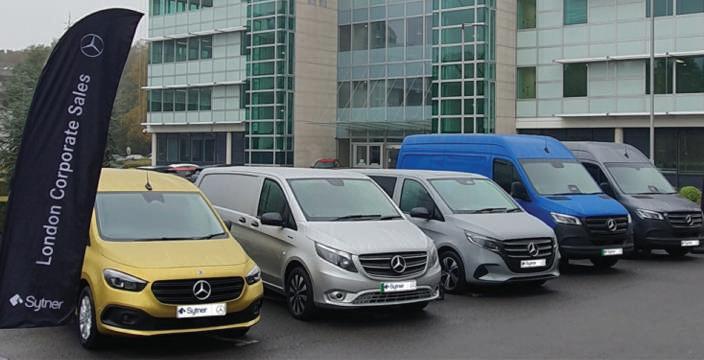
Sustainability: The eCitan helps businesses adopt a more sustainable approach, reducing carbon emissions and meeting environmental regulations such as the Ultra-Low Emission Zone (ULEZ) requirements in London.
The eCitan provides the perfect solution for businesses looking to position themselves as green and forward-thinking,.
Reduced operational costs: With the rising cost of fuel, operating an electric vehicle like the eCitan is a smart financial decision for SMEs. Charging an electric van costs, a fraction of what it takes to fuel a traditional diesel vehicle, and with fewer moving parts, the eCitan offers lower maintenance costs over time with the added benefit of our Integrated Service Package (ISP*) included free of charge*.
How London Corporate Sales can support your business
For businesses considering the Mercedes-Benz Citan or eCitan as part of their fleet, the London Corporate Sales team provide essential support, guidance, and resources to ensure these businesses are able to make the most of these innovative vehicles.
Tailored Fleet Solutions: Our corporate sales team can help SMEs determine which vehicle configuration best suits their needs. Whether a business needs a standard Citan or is looking to transition to the eCitan for environmental reasons, the team can assess the company’s requirements and recommend the right vehicle(s) for their fleet.
Financial and leasing solutions: For many SMEs, managing cash flow is critical. London Corporate can provide various financing options, from leasing agreements to outright purchases, designed to ease the financial

burden. Leasing is often a particularly attractive option for SMEs, as it allows businesses to avoid the high upfront costs of purchasing a new van, while maintaining access to state-of-the-art vehicles.
Additionally, the UK government’s incentives for electric vehicles, such as grants and tax breaks, can be leveraged to make the eCitan even more affordable for businesses.
Aftersales Support: Commitment to customer service is evident in our approach. One of the standout features of Mercedes-Benz’s service is its aftersales support. Mercedes-Benz offers comprehensive service packages for maintenance, repairs, and vehicle management, ensuring that SMEs are supported throughout the lifetime of their vehicles. Our dedicated Corporate Customer Service department can provide additional support to get you back on the road as quickly as possible.
The push towards electric vehicles like the eCitan, eVito and new eSprinter aligns with broader industry trends, where sustainability is no longer optional but essential.
Businesses are increasingly held accountable for their environmental impact, and we aim to assist by supplying them with the tools they need to lead the charge towards a greener future.
Want to know more?
To experience and evaluate the Citan or eCitan for you and your business, or to discuss your LCV fleet requirements wherever you may be in the UK, our highly experienced Corporate Account Managers – Tracey Stewart and Cheryl Scott are available. Please email them at mbvans@sytner.co.uk



Mercedes-Benz’s small electric van, the eCitan, landed at CC&V Towers for a test drive earlier in the year. As with the diesel Citan, it’s based on the Renault Kangoo but Mercedes has been at pains to demonstrate its role in development. Andrew Walker reports...
Trims and body styles
There are two trim levels, Progressive and Premium, with L1 and L2 wheelbases offered. Prices start at £33,995 + VAT
Powertrain and range
Fitted with a 45kWh battery, the eCitan comes with a WLTP range of 175 miles.
Performance
The system produces 122hp with 245Nm of torque, leading to a 0–60mph time of 14 seconds and a top speed of 84mph.
The eCitan supports AC charging up to 22kW and DC charging at up to 75kW. Charging at home on a 7kW wall box will take 6.5 hours. More at www.rolecserv.com/ home-charging. On a 75kW rapid charger a 10-80% top-up will take just 38 minutes. There’s a handy charging cable bag which can be secured in the rear load space, and you can open the charging socket via a dashboard button. The socket is located underneath the MB three-pointed star in the centre of the front grille. And on the key fob there’s a cable unlock function too.
While the rear is almost identical to the Renault and Nissan, with mid-height rear lights, Mercedes has chosen to ‘MB’ the front end with its own grille and front end. It’s a little bland to look at compared with the nose on a Kangoo but it does keep the Citan in line with the other vans in the Benz range.
The cabin is where the Citan really shines as it features a better quality finish and look to what you’ll find in the Kangoo or Nissan Townstar. It’s actually very Mercedes-like, with cylindrical air vents, Mercedes’ own MBUX infotainment system, with a really nice touchscreen, and a higher quality finish than its siblings. The hard plastics look very car-like, with separate climate controls that feature digital displays within the dials. There are also some useful short cut button under the screen. Lower down you’ll find two USB C inputs and a 12v socket.
Decent as well, with door pockets large enough for 1.5 litre bottles, twin centre cupholders, a sizeable glovebox, an overhead storage shelf, a small under armrest area and lidded storage on top of the dash. You can specify a meshed or a fixed bulkhead plus a fold-flat passenger seat if you want to carry longer loads.
The electric gear lever is located high in the middle of the dash and the driver’s seat offers height and lumber adjustment. The steering wheel comes with both reach and rake. However, as we found out in the eKangoo and Townstar EV, with the fixed

bulkhead fitted to our test van there’s not much room to push the driver’s seat back. Taller drivers take note.
The front doors open a full 90 degrees for access and our test van’s side opening sliding door measures 615mm on the left of the vehicle. You also get a 59cm low loading sill height for easier access with a 1059mm height. Load length is 1806mm, load width 1524mm and load height is 1256mm. Payload is 499kg + 75kg for driver.
The L1 can take a pair of Euro pallets and comes with a single sliding side door as standard. On the L2 models, the twin sliding side doors are wider, increasing from 615mm to 831mm wide so are large enough to load a Euro pallet through them.
Both models come well equipped. The Progressive model offers 16” steel wheels, air-con, heat insulating glass, Active Brake Assist, keyless go, LED interior lighting, cruise control, rear parking sensors and reversing camera, the MBUX infotainment system with smartphone integration, DAB, WiFi hotspot, Bluetooth and a multi-function steering wheel. Premium adds 10-spoke alloys, metallic paint, body coloured bumpers, high beam assist, LED headlights and fog lights. You also benefit from some decent safety features including, ABS, ESP, six airbags, autonomous emergency braking, hill-start assist, crosswind assist and attention assist. You can add extras too, including active lane-keeping assist, blindspot monitors and speed limit assist. Continued on page 46

Continued from page 44
Technology includes smartphone integration through Android Auto and Apple CarPlay via the C USB input. The screen icons, clarity and ease of use are first class and certainly better than the systems fitted to the Renault and Nissan vans.
Warranty
There is a three-year unlimited mileage warranty and eight-year /160,000km / 100,000 miles/ battery guarantee for extra reassurance. e Citan also comes with up to 30 years roadside assistance with out of charge cover included and an integrated service package.
The warranty package includes T4 free services – two-year A (minor) and two-year B (major) services. These are transferable with ownership
In partnership with RightCharge, Mercedes-Benz Vans is offering customers with a fleet size of 50 vans or less £1,000 (incl. VAT) towards the purchase and installation of a chargepoint when they buy the new eCitan.
Utilising the load bay
Access via the rear doors is good, as is access via the kerbside sliding side door. The rear doors are heavy and open and close with a decent thud. The side door doesn’t feel quite as sturdy, so you may want to consider some inside door protection for your own piece of mind.
On the road
We were testing the eCitan L1 Premium panel van. As with other small electric vans, it’s a cinch to drive. In town its short, squat dimensions make for nimble city driving and parking is a doddle thanks to the rear view camera, which shows up on the touchscreen when you select reverse.
The eCitan handles the urban jungle very well, even keeping bad road surfaces at bay despite the extra battery weight located under the load floor. It’s good in corners and hugs the road well, and we’d go as far as to say that the battery adds to the vehicle’s road holding, and it’s not noticeably bouncy for an unladen van.
The cabin is quiet even when you accelerate to nip in and out of traffic. At higher speed though, some wind noise does enter the cabin thanks in the main to the large exterior mirrors, but actual tyre noise is reasonable. Any driver who regularly negotiates city streets will find it more relaxing in the electric Citan than driving the diesel version.
On the motorway we selected cruise control and set off at 60mph. We did increase speed to 70mph but as I’m sure operators are aware, this significantly reduces the van’s range. Best to stick to 55-60mph as we did on a sojourn to Liverpool and back where the eCitan comfortably managed a mile travelled



to every mile of range used.
The eCitan also features a DYNAMIC driving mode button on the dashboard, so you can choose from Eco or Comfort. If you select Eco mode then the baby Benz won’t go faster than 70mph, including when you’re driving in cruise control. This will help you eke out a few extra miles if used regularly as it slows down the vehicle’s responses.
Pros
This baby Benz CV offers a lovely car-like cabin and a high quality infotainment system. It is a quiet, easy-to-drive urban companion. Safety is high on all models. It comes with zero emissions.
Load volume and load capacity are far from class leading. The electric Citan is more expensive than the petrol versions. The fitted bulkhead means that taller drivers can’t push the driver’s seat back quite as far as perhaps they’d like.
Lovely car-like cabin and high quality infotainment... quiet and easy to drive “ “


The eCitan sees Mercedes heading in the right direction with its 175-mile driving range. There’s some clever storage solutions in the cabin and it has the nicest interior of any small van. Furthermore, it offers a quiet, relaxed driving experience which, when coupled to swift acceleration, is a real bonus when negotiating urban traffic.
CC&V RATING: N N N N


